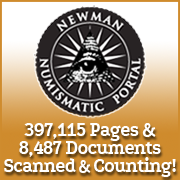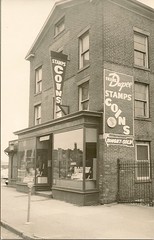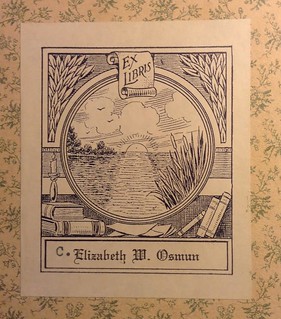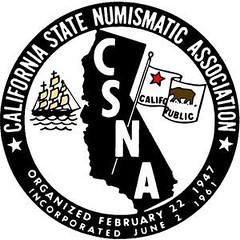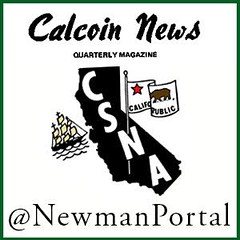
About UsThe Numismatic Bibliomania Society is a non-profit organization devoted to the study and enjoyment of numismatic literature. For more information please see our web site at coinbooks.org SubscriptionsThose wishing to become new E-Sylum subscribers (or wishing to Unsubscribe) can go to the following web page link MembershipThere is a membership application available on the web site Membership Application To join, print the application and return it with your check to the address printed on the application. Print/Digital membership is $40 to addresses in the U.S., and $60 elsewhere. A digital-only membership is available for $25. For those without web access, write to: Terry White, Treasurer AsylumFor Asylum mailing address changes and other membership questions, contact Terry at this email address: terrywhite5475@yahoo.com SubmissionsTo submit items for publication in The E-Sylum, just Reply to this message, or write to the Editor at this address: whomren@gmail.com BUY THE BOOK BEFORE THE COIN |
- WAYNE'S WORDS: THE E-SYLUM OCTOBER 16, 2016
- KOLBE & FANNING SALE 143 OCTOBER 21-22, 2016
- BOOK REVIEW: MEDALLIC WASHINGTON
- PODCAST: NUMISMATIC BOOKS WITH DAVID FANNING
- NEWMAN PORTAL DIGITIZES FREEMAN CORRESPONDENCE
- NOTES FROM E-SYLUM READERS: OCTOBER 16, 2016
- VOCABULARY TERM: CONGRUENT MASS
- CYRUS EMMANUEL BREDER (1842-1913)
- MORE COIN SHOP TALES
- 1942 GLASS EXPERIMENTAL DISCOVERED
- ON THE LIFESPAN OF DIGITAL MEDIA
- WAYNE'S NUMISMATIC DIARY: OCTOBER 16, 2016
- PAN AUCTION CLOSES OCTOBER 28, 2016
- SELECTED MEDALS FROM STACK'S BOWERS NOVEMBER 2016 SALE
- UMAYYAD DINAR FROM THE CALIPH'S MINE AUCTIONED
- SHROFF MARKS
- LORD ASHCROFT ADDS 200TH VICTORIA CROSS
- GERMANY’S WWII SOCIAL WELFARE NOTES
- COUNTERFEIT DETECTION: 1920 PILGRIM HALF DOLLAR
- THE BIGGEST ART HOAX IN HISTORY?
- DAVID HOCKNEY'S $2,500 BOOK
- MING DYNASTY BANKNOTE FOUND INSIDE SCULPTURE
- INTERVIEW: BANK OF ENGLAND’S VICTORIA CLELAND
- BANK OF CANADA CONSIDERED DROPPING BRITISH MONARCHS
- THE OCTOBER 2016 U.S. MINT FORUM
- PROPOSALS ADVOCATE ELIMINATING CENT AND NICKEL
- WHERE CASH IS NO GOOD
- COMPANY RECOVERS COINS FROM TRASH
- MAN BUYS UNDERWEAR WITH COUNTERFEIT MONEY
- IMAGES OF ALIENS ON WEIRD COINS
- FEATURED WEB PAGE: HOBBY PROTECTION ACT
Click here to access the complete archive
To comment or submit articles, reply to whomren@gmail.com
WAYNE'S WORDS: THE E-SYLUM OCTOBER 16, 2016
New subscribers this week include: Jason Hoffpauir. Welcome aboard! We now have 2,026 subscribers.
This week we open with a sale reminder from Kolbe & Fanning, a review of the new Medallic Washington book, an interview with literature dealer David Fanning, and the latest addition to the Newman Numismatic Portal.
Would Canada ever drop its tradition of depicting the reigning British monarch? What's next for the U.S. Mint? Will the half dollar make a comeback? Will the cent and nickel disappear? Will cash itself disappear altogether? We have several future-looking articles for your consideration this week.
Other topics this week include shroff marks, coin shop tales, Lord Ashcroft's latest Victoria Cross, the Bank of England's Chief Cashier Victoria Cleland, Germany's social welfare notes, and a 1942 experimental pattern in glass.
To learn more about congruent mass, William Spohn Baker, C. Elizabeth W. Osmun, Adison Smith, Harley Freeman, Joe Foster, the institutional memory of the numismatic hobby, a waffled 1931 French Indo-China Piastre, the Lord Anson Medal, and the Hobby Protection Act, read on. Have a great week, everyone!
Wayne Homren
Editor, The E-Sylum
KOLBE & FANNING SALE 143 OCTOBER 21-22, 2016
Kolbe & Fanning wish to remind everyone that our 143rd sale of important numismatic literature will be held this Friday and Saturday, October 21 and 22, 2016.
The sale is arranged in two parts:
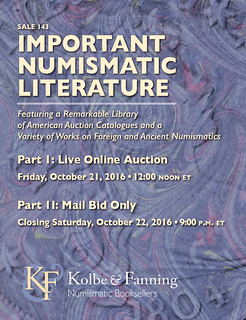 --Part One, featuring 293 lots, will be conducted as a live online sale on Friday, October 21. Bidders may participate in this part of the
sale in a variety of ways: in advance via mail, phone, fax or email--or on the day of the sale through our live bidding platform at
auction.numislit.com. Register in advance, browse lots and place bids at your leisure: all lots in the first part are illustrated in the online
catalogue. Live bidding will commence at noon eastern time on October 21. Any absentee bids not placed online must be received by Thursday, October
20 to give us time to process them. Bids may be placed with David Fanning by email to df@numislit.com or by phone at (614) 256-8915 or fax at (614)
414-0860 through Thursday.
--Part One, featuring 293 lots, will be conducted as a live online sale on Friday, October 21. Bidders may participate in this part of the
sale in a variety of ways: in advance via mail, phone, fax or email--or on the day of the sale through our live bidding platform at
auction.numislit.com. Register in advance, browse lots and place bids at your leisure: all lots in the first part are illustrated in the online
catalogue. Live bidding will commence at noon eastern time on October 21. Any absentee bids not placed online must be received by Thursday, October
20 to give us time to process them. Bids may be placed with David Fanning by email to df@numislit.com or by phone at (614) 256-8915 or fax at (614)
414-0860 through Thursday.
--Part Two, featuring over 800 lots, will be conducted as a traditional mail-bid sale with no online component. This second part of the sale will close at 9:00 pm eastern time on Saturday, October 22. Bids may be placed via mail, phone, fax or email up until that time; bids will be treated as limits and reduced as competition dictates.
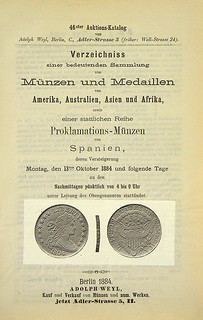
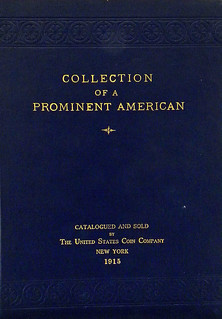
Printed catalogues have been mailed to established clients; a PDF of the catalogue has been posted to the main numislit.com website for those who prefer to read online. In addition, prospective bidders are able to access the live online catalogue and register to bid in Part One of the sale through auction.numislit.com. We strongly recommend that bidders register in advance in order to avoid any last-minute difficulties. We are looking forward to the sale and hope you are as well. Thank you in advance for your participation.
Kolbe & Fanning Numismatic Booksellers LLC is a licensed and bonded auction firm in the State of Ohio. For more information, please see the Kolbe & Fanning website at numislit.com or email David Fanning at df@numislit.com.
To read the earlier E-Sylum articles, see:
KOLBE & FANNING SALE 143 OCTOBER 21-22, 2016
(www.coinbooks.org/esylum_v19n40a02.html)
KOLBE & FANNING SALE 143 OCTOBER 21-22, 2016
(www.coinbooks.org/esylum_v19n41a02.html)

BOOK REVIEW: MEDALLIC WASHINGTON
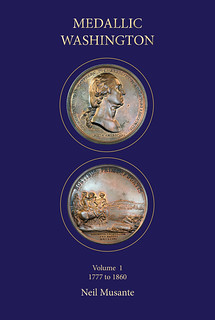
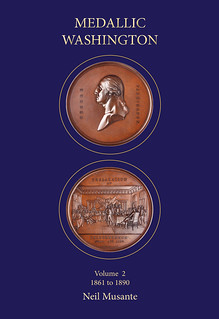
Washingtoniana has enjoyed a central place in American numismatics for more than a century and a half. Despite this, its literature has had high points and low points. James Ross Snowden’s 1861 A Description of the Medals of Washington was the first high point. That initial entry into the field came with the imprimateur of the United States Mint and all the stature that came with it. Only an extraordinary effort could bump it from its perch, but that effort came just two decades later, when William Spohn Baker released his Medallic Portraits of Washington in 1885. Numismatists never took to Baker’s Engraved Portraits of Washington, published in 1880, but Baker’s book on coins, medals, and tokens became the bible in the field.
Like the original bible, Baker’s work reached the masses only after a masterful editing. George Fuld’s 1965 edition maintained the dignity and layout of the original, but added illustrations, useful marginalia on rarity and provenance, an excellent introduction, and a useful suffix on compositions and values. The book was worthy of Fuld’s expertise and breathed a new life into a then-dusty tome.
If Krause Publications giveth to the world of Washingtoniana with the 1965 Fuld edition, it tooketh away with the 1993 Fuld-Rulau debacle. Rife with errors, laid out with the energy and discernment of a toddler running through a pile of autumn leaves, it introduced chaos and misinformation into a field that had previously enjoyed organization and scholarship. While the world of exonumia collecting bloomed at the dawn of the 21st century, the most august of American exonumic specialties remained lashed to an anchor bound in colorfully decorated boards. Only freeing itself from the Rulau-Fuld book would allow the world of Washingtoniana to flourish once more.
The first time I met Neil Musante, I told him he had written the perfect book. Neil’s work on the products of Springfield, Massachusetts engraver John Adams Bolen was a simple masterpiece: perfectly organized, nicely illustrated, compactly bound and delivered, replete with original research that answered every conceivable question. As I didn’t know Neil when he wrote it, I could only imagine it had sprung from his hands like Athena from the forehead of Zeus: fully formed and damn near flawless.
Having become friends with Neil, I now have greater insight into his research and writing process. He is indefatigable, an easier laurel to lay at his feet than the word is to pronounce aloud. He flipped every stone, photographed every collection, spoke to every specialist, and considered every theory. It took him years. The product of his Herculean labors would embarrass Baker and offend Snowden, as he has neatly outdone them both.
Neil’s book is big. Too big, if you ask me, if only because I yearn for new enthusiasts of Washingtoniana to have a paperback that will engage and edify them for the price of a pizza. Neil’s work could not be so restrained, and one volume became two. Editing the books for length would have affected their subject mastery, so while I rue the fact that new collectors are unlikely to plunk down the price tag, I’m glad to have every single page. All the standard information is there: artists (some newly identified) and minters, designs and compositions, rarity and notable offerings. The special information is there too, with easy to read storytelling and fascinating context on each medal and raison d’etre. Neil included Rulau’s sometimes fanciful list of compositions, a reflection of his easygoing personality as much as anything. When Rulau received reports of a medal existing in white metal, lead, pewter, and spelter, he liked to list four different alloys instead of recognizing four different descriptions of medals that were otherwise identical. It’s a small complaint, but one that may continue to trip up perfectionists and completists.
Other faults are few. Neil and I have some disagreements on the histories of particular medals; it is fortunate that dueling was no longer an option when we discussed whether the Sansom medal or the Halliday medal that copied it came first. Neil will probably point out some typos, but no one else is apt to care. There are some things that smell like fantasies to me that Neil includes out of a sense of responsibility to those who have included them in the past. Future collectors will undoubtedly be glad to have them in the book rather than melted into a single large decorative lawn ornament, as I would prefer.
Snowden wrote a foundational reference whose usefulness will endure. Baker wrote a landmark that has defined how collectors approach a daunting field. Musante has created the ultimate work on the medals of George Washington, a magnum opus whose writing should be appreciated, but not without recognizing the research and organization that allows it to shine so brightly.
Sturdily bound and beautifully produced in England, Musante’s Medallic Washington is a joy to hold despite its ironic nation of origin. The price tag will only seem steep to those who haven’t seen the book. No one who professes any interest in Washingtoniana that surpasses the most trivial curiosity can live without it. My sincerest hope is that this book sells out promptly and inspires Mr. Musante to tackle further briar patches in the field of American medals. Few authors in American numismatic history have managed to handle difficult material as deftly or publish a reference as worthy of their labors.
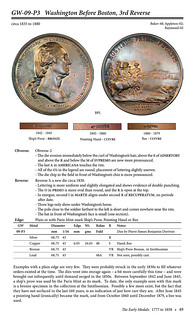
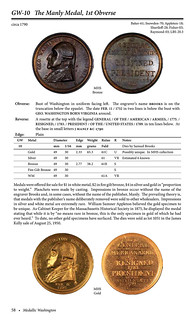
My set arrived last week and I heartily concur that Musante's magnum opus sets a whole new standard. Another Neil (Mr. Young) sang, "Hey, hey, my, my; Rock and Roll can never die". Well, neither can books. Medallic Washington is Exhibit A in the case against The Death of The Book in numismatics. It's available from Charlie Davis, who sent this ordering information. -Editor
Neil Musante’s two-volume work Medallic Washington is now available for sale. Published August in Great Britain by Spink, the initial small allotment sent by air was quickly exhausted at the A.N.A. Convention and only now has the bulk shipment been received. In two blue cloth volumes, crown quarto, 850 pages with several thousand color illustrations, Medallic Washington lists and describes with historical background 1200 tokens, medalets and medals produced through the centennial of Washington’s inauguration. The material has been completely rearranged and reorganized as reflected by the new GW-xx numbering system which should set the standard for years to come.
The set is available exclusively from the undersigned at $175.00 postpaid. A special edition edition by the Harcourt Bindery is planned. Details will be available on inquiry.
Charles Davis, Numisbook.com
Charles Davis
P.O. Box 1
Wenham, MA 01984
Tel: (978) 468 2933
Fax: (978) 468 7893
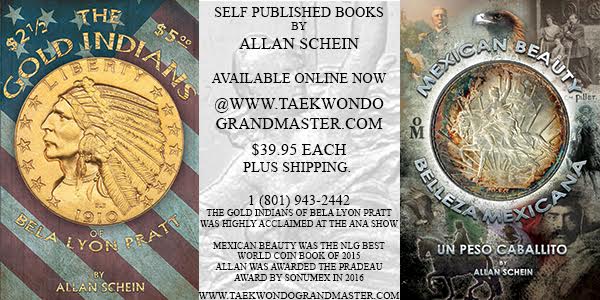
PODCAST: NUMISMATIC BOOKS WITH DAVID FANNING
CM: So how difficult is it to dig into the past in such a way where you are able to recall these colorful stories from the past?
DF: I don’t want to overstate, you know, I don’t want to sound like I’m overstating our importance here, but I see part of our job is being sort of an institutional memory of the hobby. I know for me personally, and I can speak for my partner George on this matter as well, it is the history of the hobby and the history of coin collecting in the United States (or in general) is, to us, just absolutely fascinating.
That’s not how people start out.
You know, you start out being fascinating by the coins and then maybe you start being fascinated by the literature. But as you start to really know the literature and you are able to see the connections between this book I’m looking at and the one that came out on the same topic 10 years before it and the one that drew upon it five years later, you start to see all these connections and the history of the hobby and its development comes alive for you. And it becomes very important to us. George and I, we both find that the history of numismatics has drawn so many fascinating characters, all sorts of different people. A lot of them are pretty quirky. They tend to accrue a lot of good stories. So part of why we write such often lengthy catalog descriptions is not just that we are long-winded and don’t know when to say when, it’s just, you know, we love telling these stories. They appeal to us as part of the reason that we like to collect and we have to think that we are not alone in that, that other people might enjoy hearing of these stories as well.
CM: What do you think has changed since your partnership with George has taken hold? In the market and your approach to it?
DF: The approach has only changed in the sense that we’ve had to adapt to the changing market. Our cataloging style has remained very consistent. We tend to write fairly lengthy descriptions. We get a lot of positive feedback about that. We both always have ongoing research projects. I write a regular column for the Asylum, which is the Numismatic Bibliomania Society’s publication on just whatever has been pricking my interest recently, and so I think our cataloguing style has remained more or less the same but the market has been changing a lot in the last several years. And from a business perspective, we have had to adapt to that.
CM: So how has the market changed, in your opinion?
DF: It’s become a little more complicated – it’s become a lot tougher too. Making a living selling numismatic books is not an easy thing right now. What we are really seeing is mostly overdue effects from the Internet. A lot of information that one used to have to buy books for is now available pretty readily online. That has had a real effect on things. And resources like the Newman Foundation’s Numismatic Portal has had a big influence because now a lot of this information that was kind of rarified and only in the hands of very sophisticated collectors who knew where to look for it, now its available for anyone to take a look at.
The bad side of that is that having access to that information may be enough for some people who used be customers of ours and who may no longer feel the need to buy the book if they can get the information elsewhere. The potential good side is, of course, that an entire generation is going to come about who will first be introduced to people like the Chapman Brothers, for instance, early 20th-century catalogers. Their first introduction to these sorts of works will be through the Newman Portal, and some segment of that group is going to like the idea of owning original copies of some of these things. But in the short term it has made selling certain types of numismatic books a lot more difficult.
To listen or read the complete transcript, see:
CoinWeek Podcast #43:
Numismatic Books Old and New with Dr. David Fanning
(www.coinweek.com/coinweek-podcast/coinweek-podcast-43-numismatic-books-old-and-new-with-dr-david-fanning/)
To view the complete video, see:
CoinWeek
IQ: Three Things You Should Know Before You Start to Collect Medals
(www.coinweek.com/coins/coin-collecting-strategies-2/coinweek-iq-three-things-you-should-know-before-you-start-to-collect-medals/)
NEWMAN PORTAL DIGITIZES FREEMAN CORRESPONDENCE
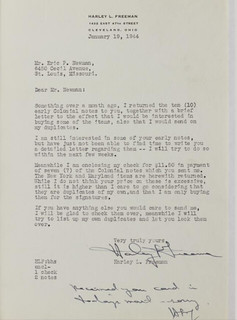 Harley Freeman, one of the foremost 20th century collectors of colonial currency, maintained an active correspondence with Eric Newman from
1943 to 1973. Newman initiated the relationship by correspondence on February 22, 1943, seeking to exchange duplicate notes, and Freeman returned an
extensive response only five days later. Freeman summed up the collecting landscape of the day – he had purchased all the major collections, noting
this “leaves me without competition, but it also causes the dealers to forget the series because there are so few who collect the notes….”
Harley Freeman, one of the foremost 20th century collectors of colonial currency, maintained an active correspondence with Eric Newman from
1943 to 1973. Newman initiated the relationship by correspondence on February 22, 1943, seeking to exchange duplicate notes, and Freeman returned an
extensive response only five days later. Freeman summed up the collecting landscape of the day – he had purchased all the major collections, noting
this “leaves me without competition, but it also causes the dealers to forget the series because there are so few who collect the notes….”
For this reason, Freeman offered that “I welcome each newcomer with open arms.” Freeman liked having the best collection, but clearly enjoyed the camaraderie as well. The two began actively trading, and Freeman represented Newman at auctions. Personal anecdotes are sprinkled throughout, and Eric’s tale of misplacing his Connecticut cents in a bathroom linen closet (November 22, 1950) is not to be missed.
In Newman’s March 5, 1962 letter, he raises the topic of purchasing the Freeman collection and writing the definitive work on early American paper money. The transaction was completed in 1963 with payment extending into 1964. As for the standard work on paper money, Freeman explained it in his letter of December 7, 1959. Freeman himself wanted to write the book and described a visit to the Philadelphia dealer Henry Chapman, who had an important collection of colonial currency.
It seems Chapman was also a would-be author and permitted Freeman to only examine the currency on the condition he not take notes. “I was so damn mad that I was tempted to walk out but I did examine his collection” Freeman wrote. Newman, of course, went on to author multiple editions of Early Paper Money of America and acknowledged to Freeman on February 28, 1967 the foundational nature of Freeman’s inventory.
Link to Harley Freeman correspondence on NNP:
https://nnp.wustl.edu/library/archivedetail/514688
Link to Harley Freeman inventory on NNP:
https://nnp.wustl.edu/library/archivedetail/514233?Year=1967&displayAmt=50

NOTES FROM E-SYLUM READERS: OCTOBER 16, 2016
More on George Kunz
Regarding the letters to George Kunz referenced last week, Roger Burdette writes:
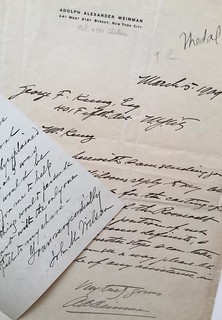 There are many letters to/from Kunz in the National Archives and Records Administration (NARA) at College Park, MD. Some of these are
quoted in my book Renaissance of American Coinage 1905-1908, but there are others. These, plus the offered letters plus others in the ANS
files and the Smithsonian archives reveal the extent of Kunz' involvement in the 1906-1908 Saint-Gaudens coinage and US coinage in general.
There are many letters to/from Kunz in the National Archives and Records Administration (NARA) at College Park, MD. Some of these are
quoted in my book Renaissance of American Coinage 1905-1908, but there are others. These, plus the offered letters plus others in the ANS
files and the Smithsonian archives reveal the extent of Kunz' involvement in the 1906-1908 Saint-Gaudens coinage and US coinage in general.
Kunz' name was once used as a threat to the Philadelphia Mint: if the Mint delayed issuing the Saint-Gaudens' $10 and $20, President Roosevelt proposed to send Kunz and a few others to the Mint to supervise the work.
To read the earlier E-Sylum article, see:
NUMISMATIC LETTERS TO GEORGE F. KUNZ (www.coinbooks.org/esylum_v19n41a20.html)
Notes from David Lange
Dave Lange writes:
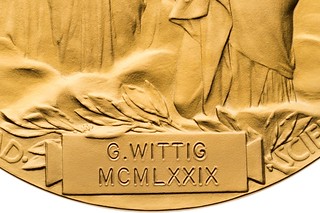 Another great issue of The E-Sylum, but I have to point out a small error. In the story about Professor Wittig's Nobel Medal
being sold you stated that it was presented in 1972. The engraving on the medal reads 1979 in Roman numerals, so that's the more likely date of
presentation.
Another great issue of The E-Sylum, but I have to point out a small error. In the story about Professor Wittig's Nobel Medal
being sold you stated that it was presented in 1972. The engraving on the medal reads 1979 in Roman numerals, so that's the more likely date of
presentation.
Another thing that caught my attention is the story about the NNP adding Sample Slab News to its library. There was mention of a chocolate Franklin Half Dollar slab put out by PCGS. It's possible that company may have created such an item, but it may also be that someone is confusing it with the one NGC produced in the early 1990s.
When I joined that company in '94 we were giving out these chocolate slabs at coin shows. Each was a full size replica of an early NGC holder made entirely of chocolate and covered in gold-colored foil. Molded into it was the image of a Franklin Half Dollar dated 1953, as I recall. These were already old at the time, a discovery I made when attempting to "sample" the sample. It was more than a bit stale.
To read the earlier E-Sylum articles, see:
WITTIG GOLD NOBEL PRIZE MEDAL UP FOR SALE
(www.coinbooks.org/esylum_v19n41a21.html)
NEWMAN PORTAL ADDS SAMPLE SLAB UPDATE (www.coinbooks.org/esylum_v19n41a08.html)
Young Numismatists of America: How Old?
James Higby writes:
There have been numerous installments in E-Sylum giving the history of Young Numismatists of America.
I was a member during my high school years, the first half of the 1960s. It had been started by a young man who lived in Flushing NY. He issued a newsletter and I wrote the coin quiz for it. Unfortunately, I cannot remember his name. But organizations with that name go back farther than I have seen mentioned.
To read the earlier E-Sylum articles, see:
THE YOUNG NUMISMATIST (www.coinbooks.org/esylum_v19n41a14.html)
YOUNG NUMISMATISTS OF AMERICA HISTORY (www.coinbooks.org/esylum_v19n41a15.html)
By Steppe, Desert, and Ocean
Bob Van Arsdell writes:
Fearing the discussion of a Roman coin in Japan would soon be explained by the intercession of extraterrestrials, I thought I might suggest a more prosaic explanation.
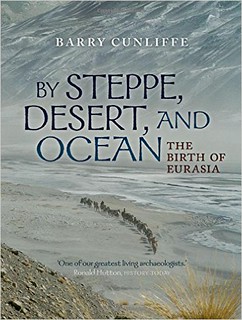 People interested in this unusual find should read Barry Cunliffe's "By Steppe, Desert, and Ocean", which explains the
origins, development and operation of the Silk Road between Western Europe and China in ancient times. Cunliffe uses archaeological evidence to make
his case. It is a remarkable book.
People interested in this unusual find should read Barry Cunliffe's "By Steppe, Desert, and Ocean", which explains the
origins, development and operation of the Silk Road between Western Europe and China in ancient times. Cunliffe uses archaeological evidence to make
his case. It is a remarkable book.
It clearly shows how exotic goods moved in both directions on the Silk Road, and exchange between China and Japan extended the trade route out into the Pacific. The Roman coin could easily have travelled from the west along the route and found a new home in Japan as a curiosity. No single traveler needed to carry the coin on its journey because down-the-line-trade would have done the job - one traveler passing the coin to the next as it went on its way.
Cunliffe's ideas should be carefully considered before the find is used as evidence for all sorts of strange events.
84, Charing Cross Rd.
Harry Waterson writes:
The shot of the interior of 84, Charing Cross Rd. brought all sorts of memories flooding back. I still have wonderful books I bought there when I worked on Denmark St in the 1990s. That is, when I could get past Foyles. But even more the picture which is of the period immediately invoked memories of the Helene Hanff book 84, Charing Cross Road one of the great bibliomaniac reads of the 20th century. First published in 1971, the book is still in print and here is a blurb from Amazon that captures the joy of the book and the reader's journey through it.
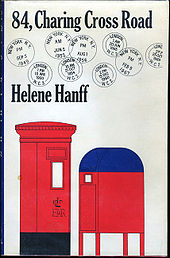 "84, Charing Cross Road is a charming record of bibliophilia, cultural difference, and imaginative sympathy. For 20 years, an
outspoken New York writer and a rather more restrained London bookseller carried on an increasingly touching correspondence. In her first letter to
Marks & Co., Helene Hanff encloses a wish list, but warns, "The phrase 'antiquarian booksellers' scares me somewhat, as I equate
'antique' with expensive." Twenty days later, on October 25, 1949, a correspondent identified only as FPD let Hanff know that works by
Hazlitt and Robert Louis Stevenson would be coming under separate cover. When they arrive, Hanff is ecstatic--but unsure she'll ever conquer
"bilingual arithmetic." By early December 1949, Hanff is suddenly worried that the six-pound ham she's sent off to augment British
rations will arrive in a kosher office. But only when FPD turns out to have an actual name, Frank Doel, does the real fun begin.
"84, Charing Cross Road is a charming record of bibliophilia, cultural difference, and imaginative sympathy. For 20 years, an
outspoken New York writer and a rather more restrained London bookseller carried on an increasingly touching correspondence. In her first letter to
Marks & Co., Helene Hanff encloses a wish list, but warns, "The phrase 'antiquarian booksellers' scares me somewhat, as I equate
'antique' with expensive." Twenty days later, on October 25, 1949, a correspondent identified only as FPD let Hanff know that works by
Hazlitt and Robert Louis Stevenson would be coming under separate cover. When they arrive, Hanff is ecstatic--but unsure she'll ever conquer
"bilingual arithmetic." By early December 1949, Hanff is suddenly worried that the six-pound ham she's sent off to augment British
rations will arrive in a kosher office. But only when FPD turns out to have an actual name, Frank Doel, does the real fun begin.
"Two years later, Hanff is outraged that Marks & Co. has dared to send an abridged Pepys diary. "I enclose two limp singles, I will make do with this thing till you find me a real Pepys. THEN I will rip up this ersatz book, page by page, AND WRAP THINGS IN IT." Nonetheless, her postscript asks whether they want fresh or powdered eggs for Christmas. Soon they're sharing news of Frank's family and Hanff's career. No doubt their letters would have continued, but in 1969, the firm's secretary informed her that Frank Doel had died. In the collection's penultimate entry, Helene Hanff urges a tourist friend, "If you happen to pass by 84, Charing Cross Road, kiss it for me. I owe it so much."
I first entered 84, Charing Cross Road to honor Hanff but went back again and again to keep up with the books.
To read the earlier E-Sylum article, see:
LONDON'S BOOKSELLERS (www.coinbooks.org/esylum_v19n41a28.html)
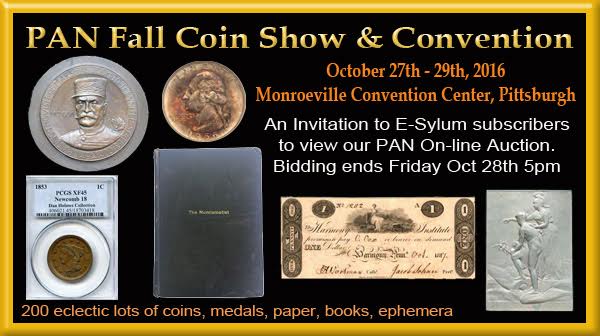
VOCABULARY TERM: CONGRUENT MASS
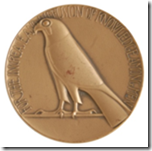
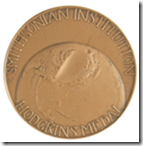
Note the sunken area in the center of the reverse, formed by internal metal flowing into the high relief eagle on the obverse. Congruent mass is a problem for single struck coins where designers and engravers must eliminate this. It is not as critical for art medals which can be multiple struck.
Congruent Mass. Heavy concentration of relief on one side of a coin or medal in respect to the corresponding point on the opposite side. An experienced coin or medal designer will never purposely put two areas of high relief back-to- back in a design to be struck. Such a situation creates very difficult problems for striking, as the core metal must flow from a greater distance to fill the two congruent die cavities. This creates an area of GHOSTING.
For single struck pieces – as in coining – this is extremely difficult; for multiple- struck medals it can be accomplished but increases the number of blows and annealing required to fully STRIKE UP each piece. For cast medals congruent mass is not a problem.
One way of separating masses on opposite sides of a coin or medal led to the widespread use of the WREATH as such a popular design element for the reverse. Obverses usually bear portraits with high relief in the center of the struck piece, the wreath on the reverse occupies an area surrounding this central area (and fits well within the circle); thus the two areas of mass are not back-to- back, not congruent.
An early American example of inept design and congruent mass is the Hard Time token created for the Bergen Iron Works of Lakewood New Jersey (due, undoubtedly, to the die engraver's manifest inexperience). His high relief on both sides – an eagle on obverse and clasped hands on rev – prevent- ed any piece from being fully STRUCK UP as the devices on both sides always appear weakly struck.
England's Royal Mint Report of 1932 (p 12) discussed this problem but called it "out of balance" designs.
Reference: NC8 {1988} Breen, p 260 for problem U.S. Jefferson nickel.
CLASS 02.14
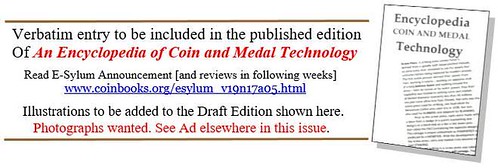
CYRUS EMMANUEL BREDER (1842-1913)
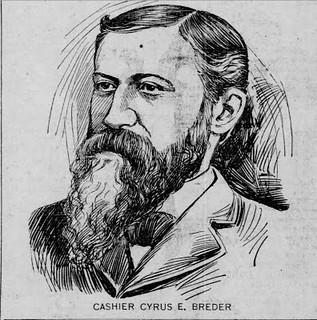 Cyrus Emmanuel Breder (1842-1913) AKA Charles E. Breder was born on June 24, 1842 in Hanover, Northampton, Pennsylvania, son of
George Breder (1812-1910), a highly respected farmer, and his wife, Susanna Schall Breder (1812-1895). His surname is sometimes misspelled as
Breeder. He was educated at the public school at Hanover. He then attended what is today Central Pennsylvania College at New Berlin. He taught public
school at Moore Township for one year and then clerked at a General store. In 1863 he became a Teller at the Bank in Hanover. He served in the Civil
War enlisted in June 1863. He was appointed Teller at the First National Bank, Bethlehem, Pennsylvania in December, 1863. Breder worked as the
Cashier at the First National Bank, Bethlehem, Pennsylvania from April 1, 1871 to December 17, 1896 when he left the bank.
Cyrus Emmanuel Breder (1842-1913) AKA Charles E. Breder was born on June 24, 1842 in Hanover, Northampton, Pennsylvania, son of
George Breder (1812-1910), a highly respected farmer, and his wife, Susanna Schall Breder (1812-1895). His surname is sometimes misspelled as
Breeder. He was educated at the public school at Hanover. He then attended what is today Central Pennsylvania College at New Berlin. He taught public
school at Moore Township for one year and then clerked at a General store. In 1863 he became a Teller at the Bank in Hanover. He served in the Civil
War enlisted in June 1863. He was appointed Teller at the First National Bank, Bethlehem, Pennsylvania in December, 1863. Breder worked as the
Cashier at the First National Bank, Bethlehem, Pennsylvania from April 1, 1871 to December 17, 1896 when he left the bank.
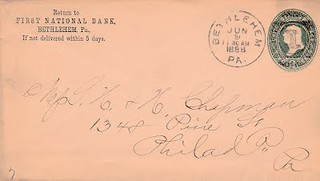 In 1863, he married Augusta Matilda Malthaner (1843-1921) at Bethlehem, Pennsylvania. They had six children three daughters and three sons,
George Alfred Breder (1867-1867), Frederick H. Breder (1868-1868), and Charles Marcus Breder (1870-1937). They lived at 332 Market Street, Bethlehem,
Pennsylvania. They lived comfortably at Bethlehem and had a domestic servant named Emma Gruber. In 1891, both he and his youngest and only surviving
son Charles joined the ANA, Member Nos. 71 and 79 respectively. He was a frequent buyer with the Chapman Brother. There are forty pieces of
correspondence from Breder to the Chapman Brothers from 1888 to 1894. He also invested heavily in stock speculations until December 1896.
In 1863, he married Augusta Matilda Malthaner (1843-1921) at Bethlehem, Pennsylvania. They had six children three daughters and three sons,
George Alfred Breder (1867-1867), Frederick H. Breder (1868-1868), and Charles Marcus Breder (1870-1937). They lived at 332 Market Street, Bethlehem,
Pennsylvania. They lived comfortably at Bethlehem and had a domestic servant named Emma Gruber. In 1891, both he and his youngest and only surviving
son Charles joined the ANA, Member Nos. 71 and 79 respectively. He was a frequent buyer with the Chapman Brother. There are forty pieces of
correspondence from Breder to the Chapman Brothers from 1888 to 1894. He also invested heavily in stock speculations until December 1896.
After paying his ANA membership dues he left Bethlehem on December 17, 1896, traveling to St. Clair, Michigan, and became a partner with Walter Ash, an electrician, in the firm of Breder & Ash, a bicycle repair shop. Later on he sent for his wife and two daughters to join him where he established a new home for them. They joined him in spring 1897 at a time when the shop became a boom. They attended St. Paul's Episcopal Church and were respected members of their community.
Breder created sensational news that rocked the nation when he was arrested by Alfred Large of Detroit, a deputy of the United States Marshal's Office, and Jacob Bernatz of Port Huron, deputy Sheriff, on August 17, 1897 at his shop in St. Clair, Michigan for embezzling $30,000. He was discovered by County Detective Jacob Johnson of Easton Pennsylvania who had been hunting more than six months for him since early February 1897 tracking him to Toronto, Canada and then Cleveland, Ohio. Johnson learned of Breder at Toronto from a letter he mailed his wife informing her of his whereabouts in the beginning of February 1897.
When the deficiency of funds at the bank was first discovered it was first thought to be $12,000. It was reported that he confiscated from $10 to $100 at a time since his appointment as Cashier from 1871 to 1896. However, Dickerman’s United States Treasury Counterfeit Detector, No. 9, September (1897) on page 13 says he stole $30,000.00.
On February 21, 1898 he pleaded guilty to charges of embezzlement and was sentenced to seven years in prison by Judge Butler. In 1900 Breder's case came before President McKinley for review for a pardon, which was denied.
He died of acute dilation of the heart at his home at 279 Rochelle Avenue, Philadelphia, Pennsylvania on March 13, 1913. He was buried first at Catasaugua, Pennsylvania and transferred to Schoenersville Cemetery, Allentown, Lehigh County, Pennsylvania.
Remy Bourne's Fixed Price Lists & Prices Paid for Lists of United States Coin Dealers 1850-1900, Volume I, Addendum lists an August 1892 List of Rare U.S. Coins in Stock and For Sale by Cyrus E's son Charles M. Breder at their 332 Market St, Bethlehem, PA address.
The Newman Numismatic Portal turned up several references to Breder's name, including that one. Some were in reports of the Comptroller of the Currency and The Banker's Magazine relating to his position at the bank. Some results were false positives resulting from incorrect OCR (optical character recognition) of similar words in other publications. Overall, the portal was quite useful, although Dickerman’s United States Treasury Counterfeit Detector has not yet been incorporated.
Many thanks to John Lupia for his numismatic sleuthing - without the starting point of his Chapman correspondence archive and reading of Dickerman’s we wouldn't have learned much about Breder. -Editor
To read the complete article, see:
BREDER, CYRUS EMMANUEL
(https://sites.google.com/a/numismaticmall.com/www/numismaticmall-com/breder-charles-e)

MORE COIN SHOP TALES
Joe Foster writes:
Reading Ginger Raspus' article in the last E-Sylum reminded me of my days of youth!!!!! I went to high school in Waukegan, Illinois. Before I got my driver's license in 1961 or 62, I used to take the old North Shore line, which was an electric train that ran between Milwaukee and Chicago. I would go the coin dealers in the Loop and then go to North Clark St.
Sometimes (actually quite a few times) I would skip school to go to Wrigley Field to see the Cubs play, or if they weren't playing, just go to the Coin Shops!!!!!!!!
I am attaching an ancient newspaper clipping (courtesy of my mother) circa 1963 or 1964, I think. I am the big 6'2" kid on the left!!!!!!!!!!!!!!!!!
The coin trade took a big hit in 1965, if I remember correctly, and Erv, the owner......had to run it by himself....and I headed south to Virginia!!!!
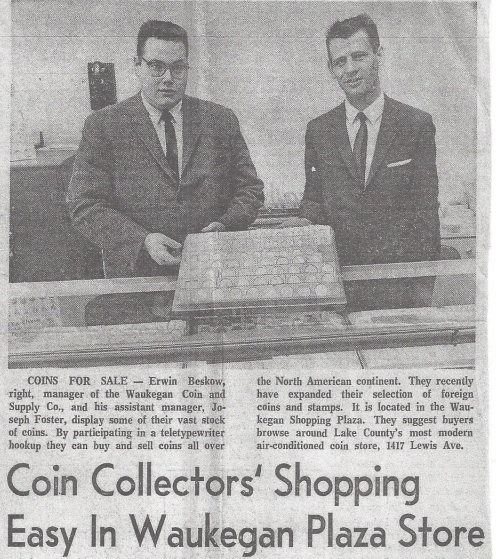
Jeffrey Zarit writes:
I have read with interest the listing of shops in Chicago, however, I think they left several out.
Regarding Erv Beskow, I believe he married one of the daughters of Bob Jacobs who at that time had a shop on, either north Kedzie or Kimball. I have not spoken to him in more than 25 years. also I remember a shop called Daru coins run by Don Urchel on Archer Ave, now called Chicago coin and run by the very professional Bill Burd.
In the loop (downtown area), during the 1960’s, there is RARCOA (formerly Ben’s Coins) which sold out to Edward Milas and after he passed RARCOA moved to the suburbs and sold out to Harlan Berk who was for years in Joliet and always longed for a shop in the loop.
Around the corner was John Ross Coins & Stamps, he usually had a very nice selection of world coins (my interest) and he was always a gentleman. Down the street from him was another small shop, the name escapes me.
At 22 W. Madison in an office building was Windy City Coins, (Marvin Frank), One street south (I think) one would find the firm of Carl & Jon Subak also in a high rise, who always had nice unusual coins there.
On Jackson a few years later was Walter (Bud) Perschke who recently passed away (he was the owner of the Brasher Doubloon).
On the South side, the previous person mentions Larry Whitlow, who was in a shopping center Evergreen Park, on 95th & Western. Further east was the shop of Joe Gaidar, and after he passed away, the shop was bought by Kraso Coins. There were others in the south part of the city, but this was as far as went.
Moving North, was Jim’s Coins in Berwyn, who worked at Sunbeam and was only open 5-9 PM and Saturdays.
And after the market crash of the mid 1960’s there were four or five shops run by Jim Bayer (now in Appleton Wisconsin) and Russ Malone. There were the shops purchased from Clem Wojdak (Miracle Mile Coins).
And I just remembered another shop in Elmhurst, Sage Coins.
Further north was Toria Coins, owned by Lucille Frost, which had a very popular bid board.
And one small shop, I cannot remember the owner’s name on Division and Milwaukee. Further north was the shop of Edwin (Red) Strauss, (on Devon near Kedzie) and when he moved north to Woodfield Mall, he sold out to Lou Goldstein (Lucky Lou’s Shop). I almost forgot, there was also a show on Devon Avenue, east of Western run by a man by the name of Friedman, he was also an instructor at Lane Tech, where I went to High School.
In the mid 1960’s there was a shop directly across from the Campus who lasted a few years.
Besides these shops, and I think I am missing a few, there were weekly coin shows around town attracting 15-25 dealers. First Sunday Elmhurst Knights of Columbus Hall; second Sunday was the show at Leaning Tower YMCA; third Sunday was Banana’s Steak House on the south side, and fourth Sunday was a show at the North Town Bowling Alley on Oakton in Skokie in the basement.
These shows are where I got my best education as the dealers who set up were always interested in talking about coins in general. Alas, most of the gentlemen from above are no longer with us. And the market has totally changed from shops where one could always enjoy a cup of coffee or a soda and talk about coins; to the industry we know today as the internet.
Nick Graver writes:
In the early 1950s, I had my first meaningful coin shop experiences in the establishment of Adison Smith, in the Jenkins Arcade, right in the heart of the old downtown Golden Triangle in Pittsburgh, Pa.
Smith was an older man (probably about my age now) on an upper floor in the Arcade, home to a great many offices of a wide variety of professions.
His office had a safe, a few simple counters, and a few chairs. He might be playing checkers or chess with a friend when customers arrived.
Possibly, a cigar on an ash tray, but I don’t recall any problem with it being in use.
Coin trays in the display cases would have been set out for the business day, and then returned to the safe which door was open.
He mainly had coins, not accessories, books, or other hobby items, a very traditional old coin shop.
His prices were all at 80% of the Red Book, and he paid 60% when buying. He made his living on that 20% difference. That was my introduction to numismatics as a young teenager.
I had been born into a family with a coin accumulation, my father having dropped Indian Head cents through the slotted lid on an old fruit jar. They became a Collection when I organized them.
As a newspaper carrier I went through my coins as I started on Whitman coin folders. Then advanced to bulk coins from the bank. I later graduated to nicer coin folders, took The Numismatic Scrapbook magazine, and later joined ANA, and got really serious.
My earliest attention was devoted to learning about grading, the degree of wear and damage coins had sustained as they circulated. I’ll never forget the day Mr. Smith took the time to teach me about the initial quality of the strike when a coin was minted. He showed me a large seated liberty silver coin that had “Fully Struck-up” stars (his expression,) and emphasized that they were not always that well struck. He then showed me several other classic coins, and noted the areas in each that were critical elements in determining the quality of that coin, beyond its ‘grade.’ I always considered him my mentor, and that day was my first step from coin collector toward numismatist.
Smith was very proud of his silver ANA medal awarded for 25 years of membership. It was taped under the glass in his display case. If I encounter him in an afterlife, I’ll be pleased to show him my 50 year gold ANA medal and thank him for taking the time to share his knowledge.
The post card photo of Frank Dupee Coins was his store on 209 George Street in New Haven, CT. I went there quite frequently as a kid the the 1960's. Great guy.
To read the earlier E-Sylum articles, see:
BEBEE BUYS A BANK BUILDING: COIN SHOPS IN AMERICA
(www.coinbooks.org/esylum_v19n40a19.html)
MORE COIN SHOP TALES (www.coinbooks.org/esylum_v19n41a13.html)
QUERY: FRANK DUPEE STAMPS AND COINS (www.coinbooks.com/esylum_v13n14a09.html)
MORE ON COIN DEALER FRANK DUPEE (www.coinbooks.com/esylum_v13n15a05.html)

Archives International Auctions, Sale 36
U.S. & Worldwide Scripophily, Banknotes,
and Security Printing Ephemera
October 22nd and 25th, 2016
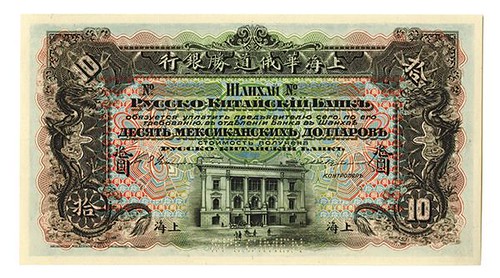
Click the links! Highlights include:
Lot 244: Government of Canada, 1883 Proof Bond
Lot 314: Marquette Silver Mining Co., 1864 Issued Stock Certificate
Lot 444: Russo-Chinese Bank, 1909 Issue Color Trial Specimen
Lot 536: Allied Military Currency, ND (1946) "A" in under print Note
Lot 585: United Arab Emirates Currency Board, 1973; 1976 Specimen Set
Lot 611: Diamond State Bank, 1866 Obsolete Note
Lot 693: Bank of New York, 1860 Proof Obsolete Banknote
Lot 804: Bank of Burlington ca.1830's Obsolete Proof
View the Virtual Catalog
Download the Catalog in PDF format
ARCHIVES INTERNATIONAL AUCTIONS, LLC
1580 Lemoine Avenue, Suite #7
Fort Lee, NJ 07024
Phone: 201-944-4800
Email: info@archivesinternational.com
WWW.ARCHIVESINTERNATIONAL.COM
1942 GLASS EXPERIMENTAL DISCOVERED
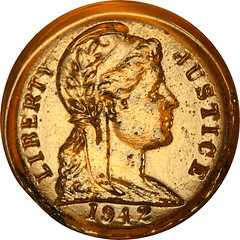
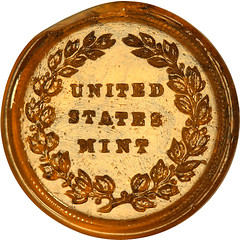
“Unique” 1942 Glass Experimental Discovered – RB 42-70, Judd 2069
Only known intact glass example of 1942 coinage experiments. A 1942 coinage experimental piece made in glass by the Blue Ridge Glass Company has been discovered by numismatic researcher Roger W. Burdette and certified by PCGS with number 81700131, graded “PR-64.” The glass experimental piece is presently held in a private collection.
The piece is made from tempered, yellow-amber transparent glass. It is identical in die alignment to the only other known example, which is broken in half. This is described and illustrated on pages 95-96 of the book Pattern and Experimental Pieces of WW-II by Burdette.
Background
During 1942 the U.S. Mint was searching for a substitute for copper used in the common one-cent coin. Copper was a critical war material and the War
Production Board refused to allocate enough to the Mint to make cents for the next year. The Mint Bureau began internal experiments that eventually
led to adoption of zinc coated steel for the 1943 coins. But the Mint also invited private companies to test various types of plastic in the event
metals were not available.
Several makers of plastic buttons and other small items were loaned a pair of cent-size medal dies prepared by Mint engraver John Sinnock. The obverse included a portrait of Liberty copied from the Columbia two centavos. The reverse design was a simple wreath designed by Anthony Paquet in the mid-nineteenth century with the words “United States Mint” added in the center.
The experiments were publicized in trade magazines and officials at Blue Ridge Glass Company in Kingsport, Tennessee, asked to participate. The Mint had a pair of used dies sent from Colt Manufacturing Co., one of the plastics experimenters, and Blue Ridge obtained tempered glass “blanks” (or “preforms”) from Corning Glass Co.
Blue Ridge had considerable difficulty in making glass 1942 sample coins. For impressing a design into glass, both glass and the dies had to be very hot – just below glass melting temperature – then the glass had to cool quickly to preserve design detail. But Blue Ridge was not able to heat the die, and the resulting experimental cents were softly detailed and had many minute surface imperfections. Blue Ridge described their process and results in a six page report, which has been preserved among U.S. Mint documents in the National Archives.
The present 1942 glass experimental piece is the only intact example discovered in nearly 75 years since the experiments. Although glass was never used for emergency U.S. coinage, this piece represents a unique artifact of the ingenuity and determination of Mint officials and private industry.
Description
Transparent yellow-amber tempered glass.
Manufactured by Blue Ridge Glass Corporation, Kingsport, TN.
Weight – 1.52 grams (approximate)
Diameter – 19.85 mm (approximate)
Thickness – 2.36 mm (approximate)
Note: The piece was made using compression molding of hot glass with cold steel dies.
Blanks (“preforms”) were slightly larger and thicker than normal one-cent pieces. All pieces were manually smoothed on the edge. Thus, weight and
dimensions will vary slightly from one specimen to another.
Designs are noticeably softer than on plastic or metal examples. Surfaces have irregular glass flow patterns as well as micro cracks and crazing of the surfaces as described by the Blue Ridge report of December 8, 1942.
PCGS Coin Information
Certificate # 81700131
PCGS # 12255
Date, mintmark 1942
Denomination 1C
Variety J-2069 Glass, RB 42-70
Country United States of America
Grade PR64
Holder Type PCGS Secure
Population 1
THE BOOK BAZARRE
ON THE LIFESPAN OF DIGITAL MEDIA
It was asserted that compared to traditional silver-based imaging, digital images have -
No Image Degradation: The negatives & positives won't fade away or be destroyed by fungus or time. They'll all be sitting on their CD-ROMS or some other technology that keeps every pixel fixed in place for years to come. Print as many copies as you like, the first will look as good as the 10,000th or 1,000,000th copy.
Mr. Davidson responds:
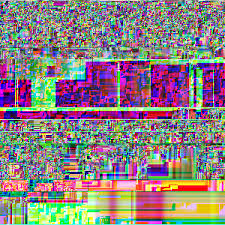 This argument is not only wrong, but backwards. Digital storage is less secure than any other form of photographic storage. As a high
priced Information Security consultant, part of what I do is consult for "Business Resumption Planning". This is the art of keeping your
digital electronic data safe and useable over a long term. A "long term" example: Hospitals in Illinois must keep patient records in a
secure form "forever"; it's the law.
This argument is not only wrong, but backwards. Digital storage is less secure than any other form of photographic storage. As a high
priced Information Security consultant, part of what I do is consult for "Business Resumption Planning". This is the art of keeping your
digital electronic data safe and useable over a long term. A "long term" example: Hospitals in Illinois must keep patient records in a
secure form "forever"; it's the law.
That's a real problem in the digital world. The current BR standard for magnetic media is two (2) years. Hum, that isn't very long in the photo world. I recently dug out some floppy disks that were last used 3 to 5 years ago. While they had been stored properly, I was unable to read or fix any of them. They all had to be reformatted. Therefore, any magnetic media - floppies, hard disk, tape, removable disk like "Zip" or "Syquest", must be regenerated every two years at the longest. Do you really believe that people will do this? They don't today.
You also have the issue of magnetic corruption that can very easily destroy your data. I hope you keep good backups. Also, molds and fungus grow just fine on disks and CD-ROMs; I've seen it.
Nobody knows how long CD-ROMs will last. The current BR estimate is 10 years. That's still not very long by photo standards. How long are you willing to wait to see if it is still readable?
There is also the conversion issue. In the past 15 years, 8" floppies, paper tape, and punch cards are all technologies that have gone by the wayside. If you were sued and had to produce data from any of these, could you? Probably not. However, if you were given a negative from a hundred years ago you could make a pretty nice print. In 10, 20, or 30 years from now what format of CD-ROM will be used? will your drive read today's disks? Will your software understand the formats? How much are you willing to bet on any of this?
I'm not "anti-digital" by any measure, however, do NOT use digital technology for photographic permanence. Sure, you can make hundreds if not thousands of "original" copies, but tomorrow that one critical byte in the header is garbage and you have nothing. If you do digital, make sure you have an evolving BRP keeps you up to date every year or two.
BTW, all of these arguments are irrelevant. People will move to digital photography (or any technology) when the cost/benefit beats out the traditional photography (or any current technology). It has always been that way and always will be that way. That is why some pros and amateurs are doing it today. That is also why most aren't.
Clyde Davidson
To read an earlier E-Sylum article, see:
BEN KEELE ON DIGITAL NUMISMATIC LITERATURE (www.coinbooks.org/esylum_v12n26a05.html)

WAYNE'S NUMISMATIC DIARY: OCTOBER 16, 2016
Tuesday October 11 was back-to-work day after the Columbus Day holiday. It being the second Tuesday of the month, it was also the meeting night of my Northern Virginia numismatic social group, Nummis Nova. We were meeting in Alexandria at Vaso's Mediterranean Bistro on King Street. Ron Abler and Joe Esposito were our hosts. In the invitation they wrote:
We suggest a space exploration theme, because on Oct 11, 1984, Astronaut Kathryn D. Sullivan, part of the crew of Space Shuttle Challenger, became the first American woman to walk in space AND on the same day in the year 2000 NASA launched its 100th Space Shuttle mission.
I was perplexed because I couldn't think of anything in my collection to bring. I think I have a couple Apollo 11 moon landing medallions from back in the day, but they're buried in a massive "everything else" box. I'd sold my blue and brown U.S. Mint packaged Eisenhower dollars years ago, along with their eagle moon landing reverses.
I arrived around 5:30 and walked around King Street a bit to see the neighborhood. I saw Ron on the street and we chatted a bit. I made a phone call then went inside and up the steps to the second floor dining room.
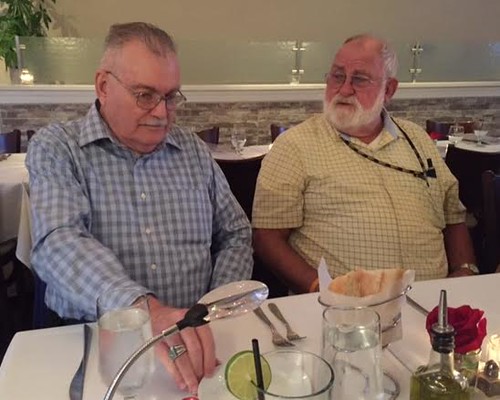
Howard Daniel and Ron Abler; Photo by Tom Kays
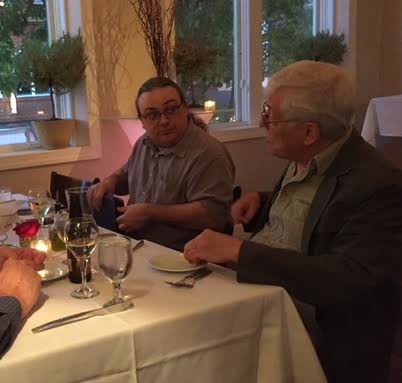
Eric Schena and Dave Schenkman; Photo by Tom Kays
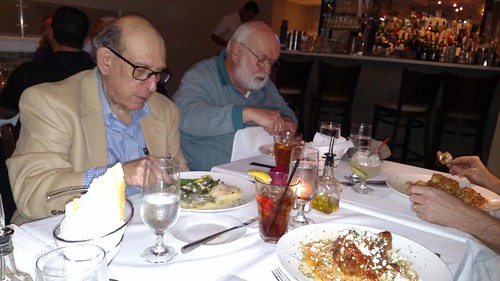
Joe Esposito and Gene Brandenburg Dig Into Dinner
Photo by Wayne Homren
Howard Daniel was already there and I sat across from him and Ron. Tom Kays came next and sat to my left. Other attendees included Eric Schena, Joe Esposito, Steve Bishop, Dave Schenkman, Gene Brandenburg, Jon Radel, Mike Packard, Wayne Herndon and Roger Burdette.
Before long Howard was showing me a couple interesting pieces he'd brought.
McCarthy For President /Support the Viet Cong
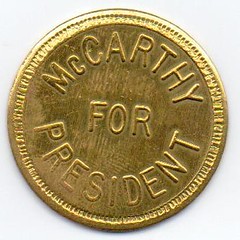
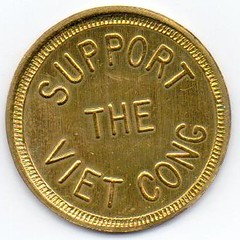
Howard writes:
The first piece I brought to the Nummis Dinner is a political piece from the Vietnam War era. It appears to be brass or bronze and weighs 4.4 grams with a 26mm diameter and 1mm thickness. It is quarter-sized in diameter but less in thickness and made to appear like a US military club token to be used in a slot machine. I would very much like to know who made it.
Waffled 1931 French Indo-China Piastre
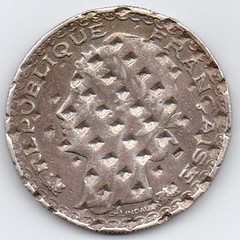
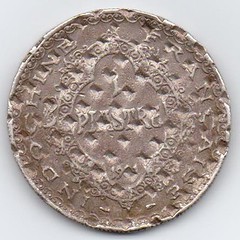
Howard writes:
The second piece I knew as "cancelled" but Wayne told me at the dinner the word to use is "waffled". I did not remember that word from numismatic articles or dictionaries. I was told by Richard C. Taylor, an advanced numismatist in France, that the waffling is not like anything done by the Paris Mint. It weighs 20.0 grams with a 35mm diameter and a 2.5mm thickness, which is correct for this piece.
I am thinking that it is one of the 16,000,000 minted that were sent to French Indochina. After WWII started with the Japanese attacking China and the German attack on France looming in the future, the French in Indochina started pulling silver coins from circulation. They needed the silver to buy opium from the highland tribes to supply the government's opium parlors. The profit from these parlors often supplied more than 50% of the government's budget!
The highland tribes refused to take paper money for their opium. During WWII, the government was running out of silver coins acceptable to the highland tribes. Low weight and low fineness coins, along with silver from other sources, were melted and made into silver bullion rounds to pay for the opium.
I am thinking that this coin was waffled in Hanoi and was to be melted for the silver rounds, but someone grabbed it out of the melting pot and took it home. If anyone has any information about this waffled coin, please contact me at HADaniel3@msn.com.
As fate has it I often end up sitting near Dave Schenkman. This time was different. I didn't get to speak much with Dave, but he passed around these great notes.
New Jersey Iron Company of Virginia
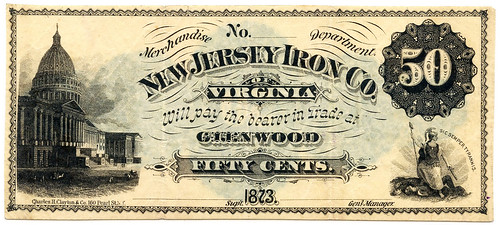
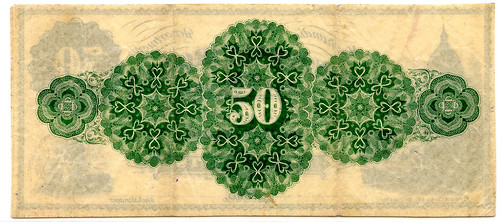
Uncle Sam's Navy Advertising Note
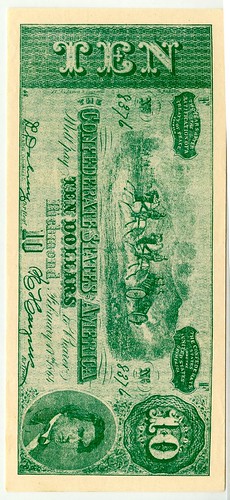
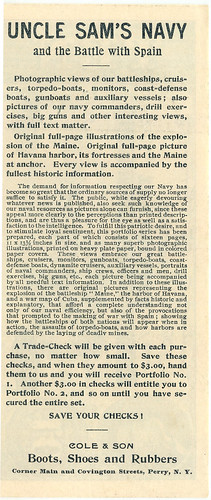
Dave noted that this advertising piece is especially interesting because the issuer mentions using "Trade-Checks" (a.k.a. tokens). He would be interested in knowing if any reader has an example of a token from Cole and Son of Perry, NY.
The Rulers of Britain Coin Collection
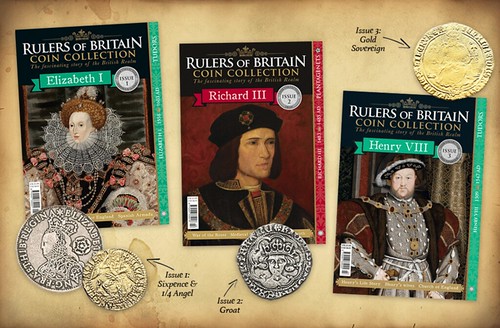
Joe Esposito showed me photos of a numismatic item he'd seen in a bookstore recently. He writes:
The Rulers of Britain Coin Collection is on sale at Barnes and Noble and presumably elsewhere. Each sealed issue includes a brief magazine on a monarch and reproduction coin. I saw a double issue, with two coins, for sale at $12.99
I added images from the product's web site.
For more information, see: Rulers of Britain Coin Collection (http://rulersofbritaincoincollection.co.uk/coins.html)
Kauko Räsänen Face Medal
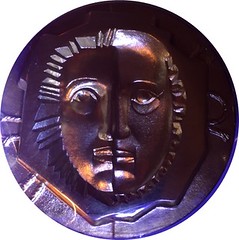
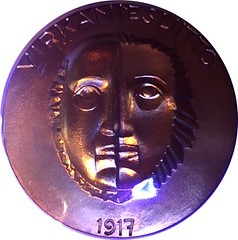
Jon Radel brought two examples of this gold-plated medal. The two sides fit into each other, but to avoid scratching the surfaces Jon left them inside their plastic packaging. Heavy!
Jon writes:
Kauko Räsänen created this medal in 1977. He is well known for pioneering work with multi-part medals and won the Saltus Award from the ANS in 1986. As such, he was only the second non-American to win the award, and the first Finn.
The medal itself honors the 60th anniversary of the founding of the Finnish Virkamiesliitto (Civil Service Association), and was commissioned by that organization. 80 mm, in 2-parts, bronze with gold plating on the inside surfaces, and an edition of 600 pieces. Cataloged in J. Hackl and D. Klose, Kauko Räsänen: Neue Wege in der Medaillenkunst, as #86.
Unfortunately, the photos aren't very good, as I've for the time being sealed the 2 halves in plastic. A fair number of the 600 instances grade as, to paraphrase, "pristine, except for the contact marks on the gilding," so unfortunately, when I take it around for show-and-tell I feel a need to protect the surfaces, which is a pity as the meshing of the two halves is much of the point to the medal.
Around 8:15 I had to go outside to feed my parking meter. On the way back in I ordered a single malt and talked with Eric a bit at the bar.
Before long the party was breaking up. We realized that our regular November meeting night would be election day, and most were in favor of changing the date. Later I followed up with November's host, who turned out to be Roger Burdette. He later made a reservation for the following Tuesday.
It was another good night of numismatic fellowship, although I regret not mingling more - I'd been a bit trapped against a wall by the seating arrangement in the small dining room. But it was fun as always. And I don't think I saw a single piece of space-related numismatica.

PAN AUCTION CLOSES OCTOBER 28, 2016
Lot 19: 1965 ANA Convention Silver and Bronze Medals
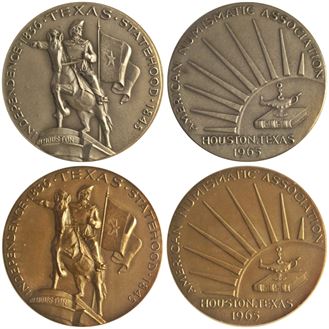
To read the complete lot description see:
1965 ANA Convention 2 medal set,
silver, bronze (www.go2coinauctions.com/Listing/Details/1821463/1965-ANA-Convention-2-medal-set-silver-bronze)
Lot 100: 1954 Paris Mint Transportation Medal
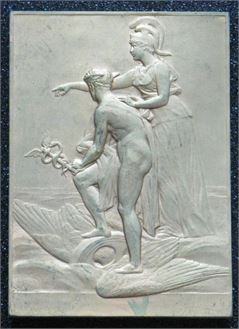
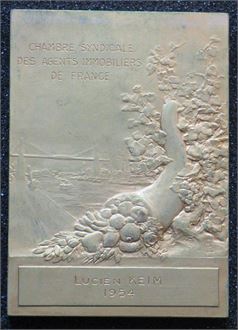
To read the complete lot description see:
Transportation
medal (Monnaie de Paris) designed by Charles Pillet, awarded 1954
(www.go2coinauctions.com/Listing/Details/1987294/Transportation-medal-Monnaie-de-Paris-designed-by-Charles-Pillet-awarded-1954)
Lot 106: 1909 Lincoln Medal by George T. Morgan
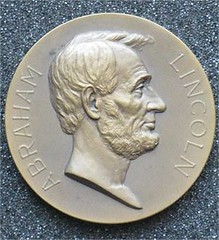
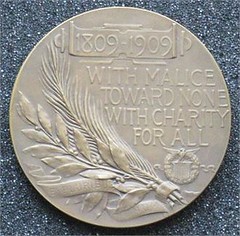
To read the complete lot description see:
Abraham
Lincoln centennial medal "Malice Toward None," by George T Morgan, 1909
(www.go2coinauctions.com/Listing/Details/1988750/Abraham-Lincoln-centennial-medal-Malice-Toward-None-by-George-T-Morgan-1909)
Lot 192: 1895 Bound Volume of The Numismatist
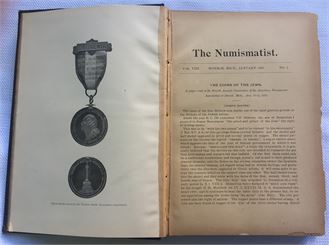
I did find a reference in The Numismatist November 1951, where "Mrs. C. Elizabeth Osmun" was given a 25-year ANA Membership Award Medal.
A further search led to the January 1976 Numismatist where we learn that her father was author and paper money specialist David C. Wismer (which could explain the "W" in her name).
"Thanks to the generosity of Dorothy C. Gershenson, we have Mr. Wismer's fifty-year gold membership medal as well as the twenty-five year membership medal of his daughter, Mrs. C. E. Osmun. These two valuable items are being added to your ANA archives."
In the March 1965 Numismatist, Elizabeth Osmun was working with a committee of the Society of Paper Money Collectors to revise her father's banknote lists.
-Editor

To read the complete lot description see:
1895 The Numismatist - hardbound year
set (www.go2coinauctions.com/Listing/Details/2167641/1895-The-Numismatist-hardbound-year-set)
To view the complete auction, see:
http://www.go2coinauctions.com/Browse?Seller=PAN-Auctions&page=0
For more information about PAN or the show, see:
http://pancoins.org/
SELECTED MEDALS FROM STACK'S BOWERS NOVEMBER 2016 SALE
Lot 7: 1683 Dutch West India Company Medal
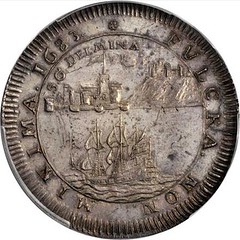
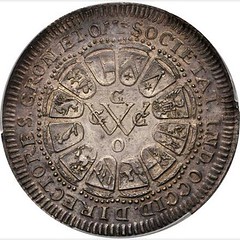
1683 Dutch West India Company. Silver. 46.0 mm. 32.6 grams. Betts-64. Plain Edge--Overstruck on a Two Ducatoon of Holland, circa 1671-1680
The Dutch West India Company (or Geoctroyeerde Westindische Compagnie) was established in 1621 by charter of the States-General of the United Netherlands. By the terms of their charter, the company was granted an official monopoly on all trade on the Atlantic including colonies in Africa, the West Indies, and North and South America. The DWC was also permitted to establish colonies in the name of the States-General, which they did with great glee and delight: Fort Oranje at Albany in 1624, Fort Nassau at Philadelphia in the same year, Fort Good Hope at Hartford in 1633, and of course Fort Amsterdam at New York City in 1626.
The company attempted to populate its new colonies with assurances of wealth through the fur trade in these regions, and offered patroonships with huge tracts of land to any investor who would pay to bring 50 new colonists to the New York settlements. During the turnover of New York to the English between 1664 and 1674, the Dutch West India Company turned its attention to settlements in modern-day Guyana and Suriname as well as African possessions such as Angola and Madagascar. In 1674, the company disbanded and reformed as the Nieuwe West Indische Compagnie, whose sphere included Curacao, the aforementioned properties on the north coast of South America, and several African ports. Their trade revolved around sugar cane, coffee, chocolate, and slaves.
This medal depicts and names one of the jewels of the Dutch West India Company crown during this period when the role of the company was changing from its height as a colonizing force in the 1620s and 1630s. The castle of St. George d'Elmina in Ghana was built in 1482 by the Portuguese and captured in 1637 by the Dutch West India Company, who used it as a center of trade in slaves and gold coming from the port of Elmina, which translates as "the mine" in Portuguese, to the Caribbean, Brazil and mainland North America. The castle, which still stands and is the oldest European building in Africa, is depicted with the striped flag of the Dutch West India Company flying above it and a well detailed galleon in the foreground.
To read the complete lot description, see:
1683 Dutch West India Company. Silver. 46.0 mm. 32.6 grams. Betts-64. Plain
Edge--Overstruck on a Two Ducatoon of Holland, circa 1671-16 (https://auctions.stacksbowers.com/lots/view/3-5T6KK)
Lot 25: Betts-382 Lord Anson Medal in Gold
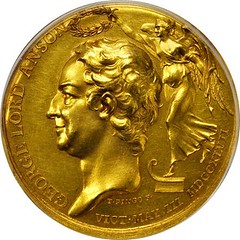
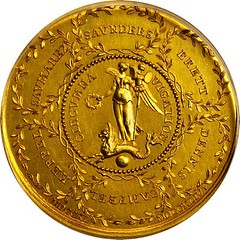
Historic Betts-382 Lord Anson Medal in Gold
To Mark His Circumnavigation of the Globe Admiral George, Lord Anson circumnavigated the globe between 1740 and 1744 and defeated the French at
Cap Finisterre in 1747, as commemorated by Fame awarding a laurel on the obverse and the names of his subordinate officers on the reverse. This medal
was likely conceived by Anson's brother Thomas about 1768; Christopher Eimer describes him as "George's older, bachelor brother, Whig
M.P., and founded of the Society of Dilettanti, whose 'cabinet of medals' is referred to by Josiah Wedgwood." Fifty examples were struck
in gold, along with 80 in silver. Eimer reports 40 struck in copper, but that number may be too low (Ford had six of them, for instance).
Thomas Pingo was perhaps the most talented of the English medalists working in the third quarter of the 18th century. He was a favorite of the London elite, a group of people who pursued numismatics, history, and art with equal vigor. Pingo's Seven Years War series for the Society for Promoting Arts and Commerce (SPAC, later known as the Royal Society of the Arts) is well known to Betts medal enthusiasts, but other works like the 1772 Botetourt for the College of William and Mary and this Anson medal are also part of the Betts corpus. Anson became a celebrated figure throughout the British Empire; Anson County, North Carolina is named for him, as is Anson, Maine. His fame was sealed by his circumnavigation, highlighted by his capture of the "Manilla Galleon," the Nuestra Senora de la Covadonga, which yielded over 1 million 8 reales in silver.
To read the complete lot description, see:
"1747" (Circa 1768) Anson's Voyage Around the World. Gold. 43.3 mm. 42.6
grams. Betts-382. (https://auctions.stacksbowers.com/lots/view/3-5T6LH)
Lot 29: 1756 Kittanning Destroyed Medal
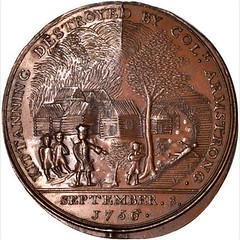
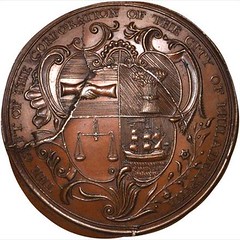
1756 Kittanning Destroyed Medal. Bronze. 44.1 mm. 47.5 grams. Betts-400, Julian MI-33. Original Dies. MS-64 BN (NGC).
A later state of this famous and popular medal, nearly 7.0 mm thick at the centers to allow for detail from the badly broken and sunken dies. The surfaces are attractive light brown with just a few well hidden specks, though the bottom edge shows a square punchmark or dent at 6 o'clock, essentially invisible from either side. The obverse is boldly cracked at 6 o'clock, while the reverse shows several curved cracks that meet in the upper center of that die.
To read the complete lot description, see:
1756 Kittanning Destroyed Medal. Bronze. 44.1 mm. 47.5 grams. Betts-400, Julian MI-33.
Original Dies. (https://auctions.stacksbowers.com/lots/view/3-5T7MS)
Lot 89: Abraham Lincoln Gold Medal Collection
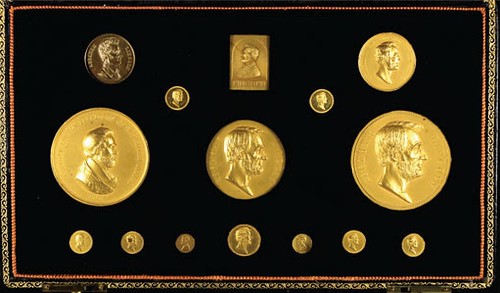
In our (Stack's) September 2010 Philadelphia Americana Sale we had the distinct pleasure of presenting for sale this unique collection of gold Abraham Lincoln medals, once a prized possession of Louis E. Eliasberg, Sr. At that time we elected to offer the set in 16 separate lots (15 individual gold medals plus the case and documents related to the set). One collector felt the set should remain together and succeeded in winning each lot in the set, keeping it intact. Five years later, when the owner decided to part with the medals, he contacted us, giving us a second opportunity to sell this historic property. Once again the medals were offered as 16 separate lots, and again, one collector sensed the importance of keeping these medals together as a set and aggressively bid for, and won, each of the individual lots. Now, for a third time, we are honored to present Mr. Eliasberg's gold Lincoln set at auction. This time, as the collecting public seems to prefer, it will remain as a set, including all 15 medals and the case, along with the supporting documents in a single lot.
In the panorama of American medallic art, only George Washington has appeared on more medals than Abraham Lincoln. Beginning with the political medals and medalets of the 1860 presidential campaign, Lincoln appeared on an ever-increasing volume of medallic issues, including pieces mourning him upon his assassination by John Wilkes Booth and all the subsequent anniversaries of his birth and of major acts of his presidency, including the Emancipation Proclamation. Over the next 150 years, medals in every imaginable metal would be struck by the United States Mint and a wide variety of private manufacturers.
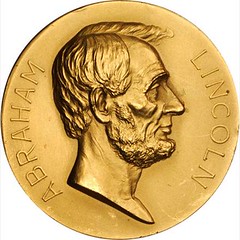
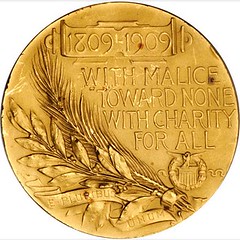
The extraordinary medals comprising this collection were first assembled by Judson Brenner, an early American Numismatic Association leader, whose collection was the basis of the Robert P. King catalog. The collection was handled after Brenner's death by Henry Chapman. It was purchased by T. James Clarke of Jamestown, N.Y. and was subsequently acquired by Stack's of New York City, who interested Eliasberg in the unique assemblage.
Now Eliasberg's, the gold Lincoln grouping included the U.S. Mint's massive Lincoln Indian Peace medal, the impressive Presidential medal by George T. Morgan, the 1871 Emancipation medal and 1909 Birth Centennial issue and seven of the tiny Mint Medalets honoring Lincoln with other historic figures. Also included are those issued by the colorful New York professional numismatist Thomas L. Elder, a passionate Lincoln admirer until his death in 1948. Modern issues are highlighted by J. Henri Ripstra's rectangular Lincoln plaquette struck in the 1930s. Ripstra, a former president of the American Numismatic Association, was a skilled medalist in his own right.
To read the complete lot description, see:
Unprecedented Abraham Lincoln Gold Medal Collection.
(https://auctions.stacksbowers.com/lots/view/3-5T8DP)
Lot 114: 1867 Cyrus Field Atlantic Cable Medal
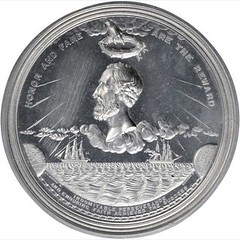
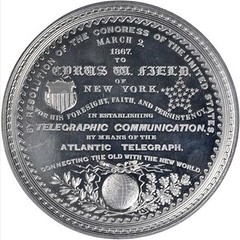
1867 Cyrus Field Atlantic Cable Medal. Aluminum. 102.4 mm. 137.5 grams. Julian PE-10c. Lustrous Mint State.
According to Julian, six aluminum medals were special ordered - ostensibly by Field himself - in January 1868. The strike is definitive and the surfaces are as deeply reflective as they are untoned. Aside from a patch of hairlines in the left obverse field, and some very faint ones elsewhere, we see no problems of note. Of use in identifying this particular specimen, there is an intriguing planchet crack running entirely through part of the medal. It is visible, on close examination, starting at the second cloud on the left of the obverse, extending through the rim and edge, and visible on the left reverse from the rim at 8 o'clock and extending nearly 3/4 of an inch into the field below the E in TELEGRAPHIC. Although technically a flaw, the crack seems to add an additional level of interest to the piece. Struck when aluminum was essentially a precious metal, and in an early brittle, less malleable formulation, this large and dramatic medal represents one of America's great technological advances.
To read the complete lot description, see:
1867 Cyrus Field Atlantic Cable Medal. Aluminum. 102.4 mm. 137.5 grams. Julian
PE-10c. (https://auctions.stacksbowers.com/lots/view/3-5T794)
Lot 116: 1826 Erie Canal Completion Medal
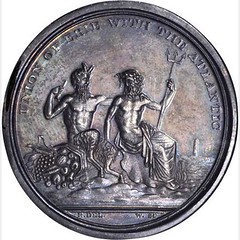
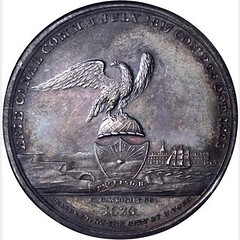
Famous 1826 Erie Canal Completion Dollar in Silver
Designed by Charles Cushing Wright
Designed by Charles Cushing Wright, the medal features Poseidon, Greek god of the ocean, and Pan, Greek god of nature, at the center of the obverse, both seated on a rock with a cornucopia, the ocean in the background with a lighthouse on shore. UNION OF ERIE WITH THE ATLANTIC curves above, R.DEL. and W. SC in the exergue. The reverse features an eagle at the center perched upon a demi-globe (much after the style of the pattern quarter dollar of 1792 by Joseph Wright), with an adorned shield bearing the Arms of New York below. A background scene of a sailing vessel and canal locks is present, ERIE CANAL COMM. 4 JULY 1817 COMP. 26 OCT. 1825 arcs above, C.C.WRIGHT SC / 1826 / PRESENTED BY THE CITY OF N. YORK on three lines in the exergue. No example of this medal has been graded equal to or higher than the present piece by NGC. The even more elusive round wooden presentation box is also included - not encapsulated, of course, and is complete and undamaged, still retaining both paper inserts.
Numismatic Reflections by Q. David Bowers
When Katie Jaeger and I compiled what became The 100 Greatest American Medals and Tokens, a Whitman best seller, collectors, dealers, scholars, and
others were invited to vote on those considered most important. The Erie Canal Medal landed in the top 10, a marvelous distinction. Beyond that, this
is one of the most historic of all American medals and is the earliest readily collectible medal by the engraver considered to be the finest in
America in the second decade of the 19th century. Medals that Wright produced at an earlier time are few and far between and very little is known
about them. Interestingly, Wright had numismatic inclinations and a few years after creating the dies for this medal, gave a lecture on ancient coins
to interested people in New York City. A book-length biography of Charles Cushing Wright is waiting to be written - his talents were immense and
covered tokens, medals, and coins (1851 $50 Octagonal), his life was fascinating, and a wealth of material is available for research and study.
THE BOOK BAZARRE
UMAYYAD DINAR FROM THE CALIPH'S MINE AUCTIONED
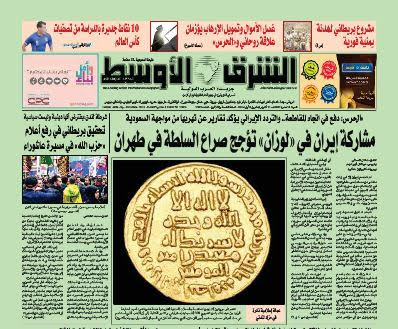
An E-Sylum reader writes:
One of my friends in London sent me this about a coin (lot 17 and on the cover) in an upcoming Morton and Eden October, 20th sale. They have told me that Al-Sharq al-Awsat is pretty much the main broadsheet newspaper in the Arabic-speaking world, and their cover coin is on the front page as well as inside the cultural section.
As you can see from the catalogue description it is related to the Year 105 they sold in 2011 for just over $6 million (which remains the highest price ever for a non-US coin).
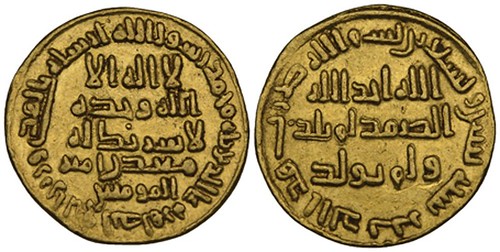
Umayyad, dinar, Ma‘din Amir al-Mu’minin 92h, obv., in field: la ilaha illa | Allah wahdahu | la sharik lahu | Ma‘din Amir | al-Mu’minin; rev., standard Umayyad type with date legend in margin, point below b of duriba, 4.25g (SICA 10, 487, same obverse die; Bernardi 47), minor marks in reverse field but generally good very fine, historically important and extremely rare. Enigmatic, historically intriguing, and of the highest rarity, Umayyad dinars from the ‘Mine of the Commander of the Faithful’ have fascinated numismatists for more than a century.
The circumstances under which they were issued are still the subject of scholarly debate, although recent research and newly published coins have advanced our knowledge considerably in recent years. Examples dated 89h, 92h and 105h have been sold in these rooms previously (the unique coin of 89h on 23 April 2012 and the other two dates on 4 April 2011). The phrase ‘Ma‘din Amir al-Mu’minin’ is found on two groups of gold coins. The earlier group, known for the years 89h, 91h and 92h and to which this coin belongs, carries these words in the obverse field below the normal inscriptions. On the later coins, known only for the year 105h, the phrase is expanded to read ‘Ma‘din Amir al-Mu’minin bi’l-Hijaz,’ ‘Mine of the Commander of the Faithful in the Hejaz,’ and is placed in the lower part of the reverse field.
The significance of the Ma‘din inscription is still debated but, as has previously been argued, there is much to be said for the simplest explanation: that it refers to a mine belonging to the caliph. While the word ‘mine’ can be used metaphorically in Arabic, all other legends found on post-Reform Umayyad gold and silver coins are either religious (verses from the Qur’an) or factual (stating where and when the coin was struck). That being said, it seems difficult to treat it as a normal mint-name, which one would expect to find in the margin with the date, and for which there would certainly have been space to include there. It has also been observed that the mints on the Umayyad silver coinage were set up in cities, or perhaps at places where the army halted on campaign, but are not otherwise known to have been set up at a mine itself.
To read the complete lot description, see:
Umayyad, dinar, Ma‘din Amir al-Mu’minin 92h
(www.sixbid.com/browse.html?auction=3041&category=62725&lot=2543150)
To read the complete article, see:
Golden Dinar Dating Back to
Umayyad Caliphate Put Up for Auction in London
(http://english.aawsat.com/2016/10/article55360192/golden-dinar-dating-back-umayyad-caliphate-put-auction-london)

SHROFF MARKS
Regarding David Pickup's question about holes found in Indian silver coins, 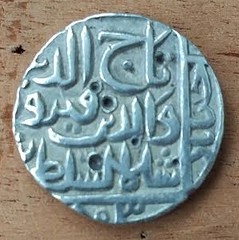 Kavan Ratnatunga of Sri Lanka writes:
Kavan Ratnatunga of Sri Lanka writes:
These are shroff marks from strikes used to check purity of the silver in the coin. There occur frequently on coins of this era and it is difficult to find one without any.
Kavan referenced this entry from the Fitzwilliam Museum's Numismatic Glossary:
chop-marks Punch marks stamped on to foreign silver coins in China as a sign that they had been tested and approved for a transaction. In India these are known as 'shroff-marks'.
To read the complete Glossary see:
www-cm.fitzmuseum.cam.ac.uk/gallery/East-West/glossary.html
Ken Spindler of San Diego writes:
I believe those are "shroff marks," i.e., hammered test punches or sites of tiny silver boring (enabling stealing tiny samples) administered by shroffs - employees of merchants or bankers who were skilled at determining silver purity by examining the color of the silver below the surface of the coin - and whether silver on the surface wasn't merely a veneer on a cast counterfeit of nonprecious metal.
Such marks are extremely common on worn "dump" style (crude, thick, unround planchets) silver coinage that circulated in India for hundreds of years. The marks are not always round. They are very often found on the edges of dump silver coins, too. Test cuts on coin edges seem to have served the same purpose(s).
I believe I read that such Indian silver testers were eventually brought into China to teach the Chinese to test foreign silver coinage accepted in commerce there as bullion, apparently beginning in the late 17th century. The Chinese versions are "chopmarks," which were larger countermarks for the same purpose, hand-hammered with a punch, much more elaborate and distinctive - so a merchant or banker might know by his mark, which was possibly always placed on the same location of a coin, whether he'd previously tested a given piece. Foreign silver in China often ended up being melted into assayed "sycee" ingots to pay taxes.
I carry a moderately worn 17th century Mughal Indian rupee bearing numerous shroff marks in my pocket change wallet in hopes it's spotted and sparks a numismatic conversation or spontaneous history discussion when out shopping. (Never happens.)
Shailendra Bhandare writes (in a note to David Pickup):
These are testing marks applied as the coin circulated, to attest whether it was fully of silver, or a forgery made by plating a copper core with silver. This was normal practice in some areas of India during this period. More number of marks will generally be regarded as a downgrading of the coin's condition. The money-changers thought that too - as we have evidence that coins with more test marks were subject to more discount!
Ken adds:
Fake Chinese chopmarks do exist, to enhance the value for chopmarked coin collectors of an otherwise boring coin which never saw China. A famous coin dealer in the US is known to have done that - Hans Schulman, who bought two genuine assay chop dies used by a Thai silversmith, one the silversmith's name in Thai, and the other, the same name in Chinese, and went crazy for a few days chopping hundreds of coins himself with the same punches.
Amongst other things, I collect Indian coins "by type" back to about 1850, and have many dozens of different varieties of "dump" rupees and partial rupees, almost all of which bear multiple tiny shroff marks, and maybe almost 100% of those include multiple shroff test marks on the edges. Because of their ubiquity, I ignore their presence and would not reject a coin because of them unless they really wreck the design elements (usually just ornate Urdu calligraphy), bend the coin, and/or harbor ugly corrosion.
David Pickup writes:
Thank you to the contributors!
To read the earlier E-Sylum article, see:
NOTES FROM E-SYLUM READERS: OCTOBER 9, 2016 : Query: Holes in Indian Coins
(www.coinbooks.org/esylum_v19n41a12.html)
LORD ASHCROFT ADDS 200TH VICTORIA CROSS
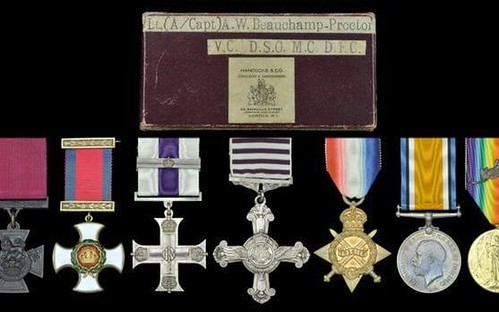
Powered flight was little more than a decade old when Flight Lieutenant Andrew Beauchamp Proctor took part in life-or-death dogfights in the skies over Europe. By the end of the Great War, he was a veteran.
Such was his brilliance and courage in the air during the first eight months of 1918 that Beauchamp Proctor ended the war as the sixth highest-scoring Allied ace of the conflict, with 54 victories. He was also one of the war’s most decorated pilots.
So I am delighted to have become the privileged custodian of the gallantry and service medals awarded to Flight Lieutenant Andrew Beauchamp Proctor VC, DSO, MC & Bar, DFC.
Even as a member of a “club” where the minimum qualification for membership is to be the “bravest of the brave”, Beauchamp Proctor’s wartime exploits are quite extraordinary. Keen “to do his bit’ as the war dragged on, he responded to a British recruiting campaign and volunteered for the Royal Flying Corps (RFC). On March 12 1917, he attested as an air mechanic, 3rd class, before sailing to England for pilot training, eventually joining 84 Squadron, RFC.
Proctor, just 5ft 2ins tall and at this time preferring to be called “Frederick” rather than “Andrew”, played a full part in the German South-West Africa campaign which saw the enemy defeated and Proctor demobbed in August 1915 so he could resume his studies.
His lack of height caused problems: he was too short to reach the rudder bar and sat too low in his seat for a cockpit view. However, he overcame these issues with a few adjustments to his aircraft.
Victoria Cross Heroes: Volume II, by Michael Ashcroft, is published next month by Biteback (£25). To order your copy for £20 plus free P&P, call 0844 871 1514 or visit books.telegraph.co.uk.
To read the complete article, see:
The tragic story of the First
World War flying ace behind the 200th Victoria Cross in my collection
(www.telegraph.co.uk/men/thinking-man/the-tragic-story-of-the-first-world-war-flying-ace-behind-the-20/)
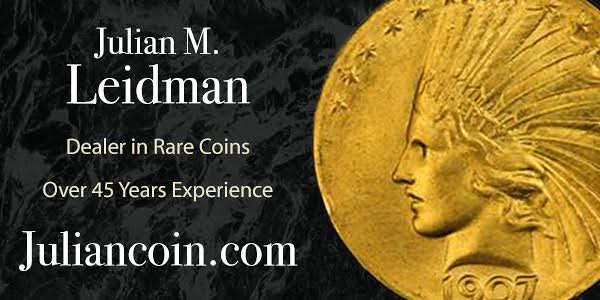
GERMANY’S WWII SOCIAL WELFARE NOTES
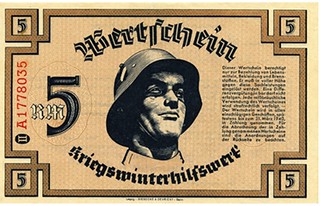 I collect World War II era lottery tickets and ephemera related to the German social welfare program known as Winterhilfswerk (known by its
initials WHW and translated roughly as the “Winter Fund” or “Winter Help Work”). This program was begun in 1931 by the German government, but Adolf
Hitler scaled it up in a massive manner in 1933, overseen by the Nationalsozialistische Volkswohlfahrt (National Socialist People’s Welfare
Organization). Germany had not escaped the worldwide depression, and the program’s slogan “None shall starve or freeze” certainly sounded laudable
enough during the dark days of the Great Depression.
I collect World War II era lottery tickets and ephemera related to the German social welfare program known as Winterhilfswerk (known by its
initials WHW and translated roughly as the “Winter Fund” or “Winter Help Work”). This program was begun in 1931 by the German government, but Adolf
Hitler scaled it up in a massive manner in 1933, overseen by the Nationalsozialistische Volkswohlfahrt (National Socialist People’s Welfare
Organization). Germany had not escaped the worldwide depression, and the program’s slogan “None shall starve or freeze” certainly sounded laudable
enough during the dark days of the Great Depression.
But the program soon became a high-pressure giving exercise that makes any modern day public participation program look like a Sunday school collection. Meticulous records of participation and giving were kept and nonparticipation simply was not tolerated.
Assistance for the needy was provided in the form of “relief notes” that were denominated in values of 50 reichspfennig, as well as 1-, 5-, and 10-reichsmark issues. The local WHW office would issue relief notes to approved recipients after stamping them as issued.
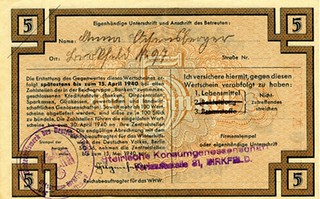 The recipients, after filling in their names and addresses on the notes, could then buy from a relatively small list of allowed items at
any participating merchant (undoubtedly, not participating was also an ill-advised decision). When the note was redeemed, the merchant stamped his
merchant information and certified what had been purchased.
The recipients, after filling in their names and addresses on the notes, could then buy from a relatively small list of allowed items at
any participating merchant (undoubtedly, not participating was also an ill-advised decision). When the note was redeemed, the merchant stamped his
merchant information and certified what had been purchased.
To read the complete article, see:
Social welfare paper ephemera
reminder of Germany’s WWII homefront realities
(www.coinworld.com/news/paper-money/2016/10/german-relief-notes-are-from-winter-help-work-program.html)
COUNTERFEIT DETECTION: 1920 PILGRIM HALF DOLLAR
In recent years, the “Classic” Commemorative series has become increasingly popular. These coins were first issued in 1892 to celebrate the Chicago World’s Columbian Exposition, with nearly a million Columbian half dollars sold in that first year. The series continued for another 62 years to commemorate a total of 48 different subjects. Most of the commemorative coins issued were silver half dollars, but there was also an 1893 Isabella Quarter, a 1900 Lafayette Dollar and a handful of gold pieces, including two incredible $50 pieces.
Due to the popularity of the series and the rarity of many pieces, counterfeits exist of many issues and are seen from time-to-time by NGC. For example, NGC recently encountered a fake 1920 Pilgrim Tercentenary Half Dollar, one of the earlier issues in the Classic Commemorative series. This attractive coin features William Bradford, who governed the Plymouth Colony a total of five times. The reverse depicts the Mayflower sailing west towards the New World.
The relatively crude forgery examined by NGC shows extensive loss of detail throughout. The letters are poorly defined and seem to flow gently into the fields. Note the lack of detail in the hair, arm and book, as well as in the masts and side of the ship on the reverse. Additionally, the D between HALF and DOLLAR (for designer Cyrus E. Dallin, not the Denver Mint) is almost completely gone. Lastly, the surface of the coin has a very odd, unnatural look.
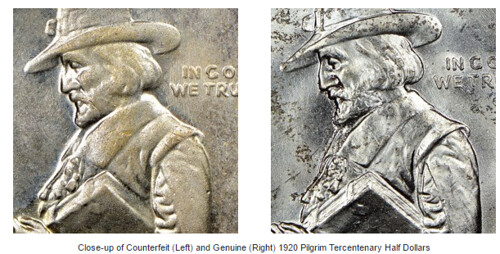
As you can see, the genuine example looks much better than the fake. The authentic coin has great luster and a strong strike. A close look reveals just how much more detail the genuine example has.
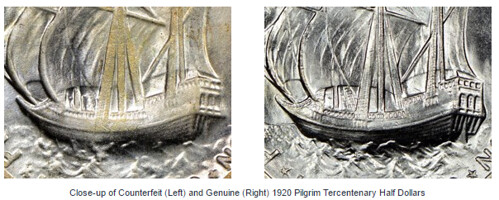
On the spurious coin (left), the lines on the book are essentially nonexistent. Additionally, the sharp lines of Bradford’s hat and clothing are reduced to mush through the die-transfer process. The difference is even more apparent on the reverse.
This counterfeit was not a particularly good one, but it can still fool an unsuspecting or novice collector.
To read the complete article, see:
Counterfeit Detection: 1920 Pilgrim
Tercentenary Commemorative (www.ngccoin.com/news/article/5579/counterfeit-1920-pilgrim-tercentenary-commemorative/)
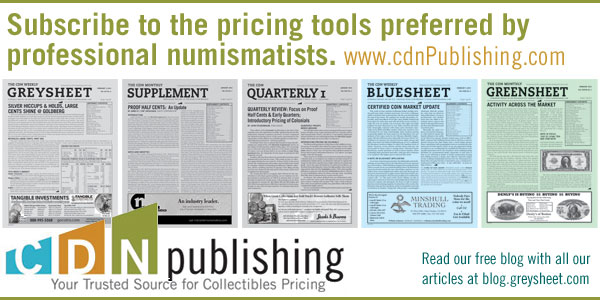
THE BIGGEST ART HOAX IN HISTORY?
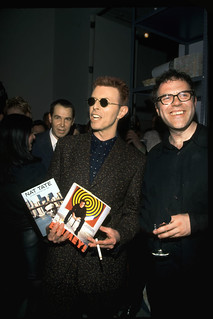 On the evening of April 1, 1998, David Bowie hosted a party at Jeff Koons's Manhattan studio. Many from the New York art world were
there because Bowie was launching the first publications of his new art-publishing house, 21.
On the evening of April 1, 1998, David Bowie hosted a party at Jeff Koons's Manhattan studio. Many from the New York art world were
there because Bowie was launching the first publications of his new art-publishing house, 21.
At one stage in the evening, Bowie read some excerpts from a short biography 21 was publishing. It was called Nat Tate: An American Artist: 1928--1960. It was full of photographs and illustrations, and it was written by me. Nat Tate was a short-lived member of the famous New York School, which flourished in the late 1940s and 1950s and included such luminaries as Jackson Pollock, Franz Kline, and Willem de Kooning. Tate committed suicide in 1960 by jumping off the Staten Island Ferry (his body was never found) after having burned 99 percent of his life's work during the last weekend of his life. Hence the artistic oblivion he found himself in almost 40 years later; only a few works remained to testify to his intriguing talent.
After Bowie gave his reading, an English journalist named David Lister, who worked for the Independent newspaper in London--a national newspaper--wandered through the crowd in Koons's studio, chatting to people about Tate. Some people claimed to have heard of him, a few had seen some of the work, and all agreed that his short, abruptly self-terminated life was very sad.
A week later, 21 Publishing planned a similar launch in London. A new restaurant, Mash, was the venue, and, just as in New York, much of London's art world had been invited. I gave major interviews on BBC Radio and to national newspapers. The eminent journalists who interviewed me were hugely intrigued by this forgotten American artist, highly curious as to how I had found out about this overlooked talent. An excerpt from the book ran in the Sunday Telegraph.
And then it was all exposed as an elaborate hoax. Nat Tate had never existed. Nat Tate was a fiction. He was a figment of William Boyd's imagination.
The hoax was broken by Lister, the English journalist at the Bowie-Koons party. He was one of the very small band of conspirators and felt he couldn't sit on this scoop any longer, and the story duly appeared on the front page of the Independent: HOW A BRITISH NOVELIST FOOLED THE U.S. ART WORLD. It was picked up internationally (it was on the front page of the New York Times Arts section), and for 24 hours it became a global talking point. I was interviewed by radio stations and newspapers around the world. I was on Voice of America. I had a 20-minute interview on the late-night news-magazine program on BBC TV. And so on and so forth. And thus the myth of the great Nat Tate art hoax was born.
It wasn't planned this way. Nat Tate was created out of a desire to experiment--to see if something entirely fictitious could experience a life in the world as something wholly credible, real, and true. I wanted to launch the book out into the public arena and see what would happen, to see who bought the story wholesale and who was suspicious. I wondered how long it would take for us to be rumbled. A month? Six months? A year or so? At the time, I was on the editorial board of an art magazine called Modern Painters, as was David Bowie, which is how we met. With the editor's cooperation, I came up with the idea of creating an imaginary painter. However, his life would be tricked out with absolute authenticity: photographs, reminiscences, examples of surviving artwork. Bowie suggested we publish it as a small, beautifully produced art monograph.
For me, the key ingredient was the testimony of people who could "remember" meeting Tate. I asked two friends--Gore Vidal and Picasso biographer John Richardson--to join the circle of conspirators. Their anecdotal testimony in the book acts with massive veridical force. Here is Gore Vidal on meeting Tate: He was "an essentially dignified drunk with nothing to say. Unlike most American painters, he was unverbal." Then Richardson describes how he introduced Tate to Picasso at a luncheon and then gained him access to Braque in his studio at Varengeville in Normandy: "It was obvious that Tate had a drink problem ... but I found him charming and unassuming." The evidence was overwhelming. It must be true. Nat Tate must have existed.
And here we are, 13 years after the event, and the phenomenon has never stopped. There have been three TV documentaries about Tate. The biography has been translated into French and German and will be republished in the U.K. and the U.S. this month. In the 2010 TV dramatization of my novel Any Human Heart, Tate is played by the actor Theo Cross. And, even more bizarrely, the first authenticated Tate drawing to go on the open market is about to be auctioned in London.
To read the complete article, see:
THE BIGGEST ART HOAX IN HISTORY
(www.harpersbazaar.com/culture/features/a695/nat-tate-art-hoax/)
DAVID HOCKNEY'S $2,500 BOOK
Dick Johnson writes:
Got $2,500 for a new book just published? Don’t whip out your checkbook too fast. You might not be able to lift it. It’s two and a half feet tall and comes with its own stand. Total weight 100 pounds.
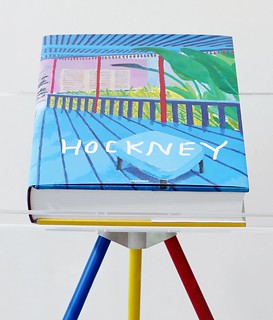 David Hockney fans take note. The beloved British artist is the subject of a massive new book, David Hockney. A Bigger Book, due out from
Taschen in November. Over two feet tall and a foot-and-a-half wide, the mammoth tome comes with a custom designed stand by Marc Newson, and costs a
hefty $2,500.
David Hockney fans take note. The beloved British artist is the subject of a massive new book, David Hockney. A Bigger Book, due out from
Taschen in November. Over two feet tall and a foot-and-a-half wide, the mammoth tome comes with a custom designed stand by Marc Newson, and costs a
hefty $2,500.
It’s the perfect showcase for Hockney’s vibrantly-colored, brilliantly perceptive works. From the cool blue swimming pools of California to the lush forests of his native Yorkshire, as well as paintings of family and friends, landscapes and portraits alike sparkle in a monograph that is truly spectacular.
This isn’t Taschen’s first rodeo with larger-than-life publications, a genre it pioneered with the 1999 monograph Helmut Newton SUMO, which, according to the Guardian, was the largest book produced in the 20th century. A Hockney SUMO has been a dream of Taschen founder Benedikt Taschen, Hockney’s good friend and Los Angeles neighbor, ever since.
A work of art unto itself, SUMO is being produced in a limited, numbered edition of 10,000, each signed by the artist. The first thousand copies will come with a signed print of his work.
“I know the book is going to last 100 years, at least,” Hockney said in a statement about the book, the most comprehensive survey of his work to date.
It features over 450 works drawn from all stages of Hockney’s 60-year career, beginning with a self-portrait from when he was just 16, way back when he was studying at the Bradford School of Art in 1953. Hockney and co-editor Hans Werner Holzwarth spent a year selecting and sequencing the included works. The publication went through 19 proof versions and 12 dummy copies before it was perfected.
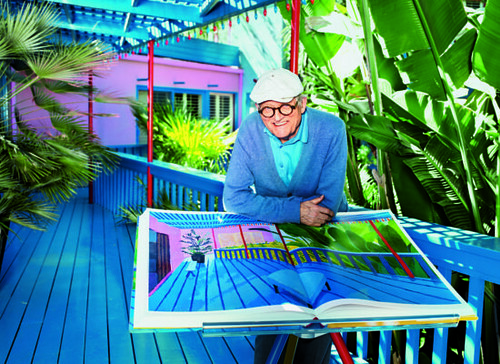
To read the complete article, see:
13 Stunning Photos Take You Inside David Hockney’s New ‘SUMO’ Book
(https://news.artnet.com/art-world/david-hockney-a-bigger-book-698846)
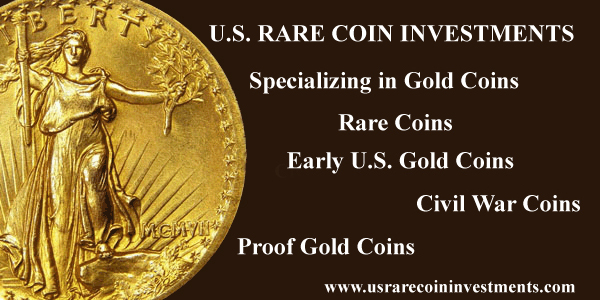
MING DYNASTY BANKNOTE FOUND INSIDE SCULPTURE
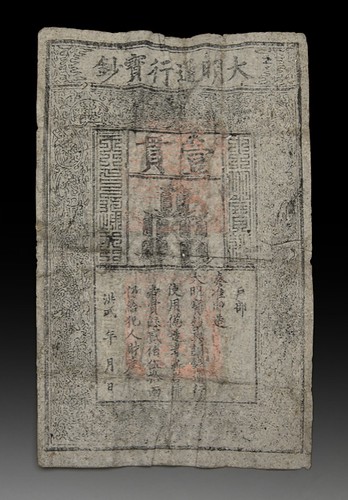 Mossgreen auction specialists in Australia have discovered a rare Ming Dynasty banknote hidden within the cavity of a 13th Century Chinese
Sculpture which is coming to London for viewing on Thursday 3 – Sunday 6 November at The Beaumont Hotel, 8 Balderton Street, Brown Hart Gardens,
London W1K 6TF (by appointment).
Mossgreen auction specialists in Australia have discovered a rare Ming Dynasty banknote hidden within the cavity of a 13th Century Chinese
Sculpture which is coming to London for viewing on Thursday 3 – Sunday 6 November at The Beaumont Hotel, 8 Balderton Street, Brown Hart Gardens,
London W1K 6TF (by appointment).
The crumpled banknote was found inside the head of a large, Chinese wooden sculpture of a Luohan which is to be offered at auction by Mossgreen as part of The Raphy Star Collection of Important Asian Art on December 11th in Sydney.
The sculpture and the banknote will be sold together as one lot. The value of the note alone is approx. AUD $3,000-5,000 but it will be sold as the one lot so the overall value is AUD$40,000-60,000.
Specialist Ray Tregaskis, Head of Asian Art at Mossgreen said, ‘It was a thrilling moment. While it was not unusual for consecration items such as semi-precious stones or scrolls to be left within the base or on the back of a sculpture, the discovery of this rare Ming Dynasty banknote is an exciting one and importantly, it verifies the date of the sculpture.’
Luohan is a Chinese word used to describe those who have completed the four stages of Enlightenment and reached the state of Nirvana. The facial features in this image of Luohan are superbly defined, and it wears a wise, serene expression.
The banknote found inside the sculpture is stamped with three official red seals and dated the third year of the Ming Dynasty, the Hong Wu period (1368-1398). The note is inscribed "Da Ming Tong Xing Bao Chao", "Yi Guan" and the lower section is inscribed, ‘Authorized by the Department of Finance, this bank note has the same function of coins, those who use counterfeit bank note will be beheaded, the whistle-blower will be rewarded 250 Liang silvers plus all the properties of the criminal. The third year of Hong Wu period.’
To read the complete article, see:
Mossgreen
auction specialists discover a rare 700-year-old Ming Dynasty banknote inside sculpture
(http://artdaily.com/news/90758/Mossgreen-auction-specialists-discover-a-rare-700-year-old-Ming-Dynasty-banknote-inside-sculpture#.WAQADuArKhd)
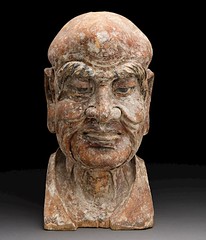 John Mutch forwarded this BBC News podcast about the note. Thanks. I added a link to an Antiques Trade Gazette article which
included an image of the scuplture. -Editor
John Mutch forwarded this BBC News podcast about the note. Thanks. I added a link to an Antiques Trade Gazette article which
included an image of the scuplture. -EditorTo read the complete articles, see:
The man who found a 700-year-old banknote (http://www.bbc.co.uk/programmes/p04brm16)
Rare Ming Dynasty
banknote found lurking inside Chinese sculpture
(www.antiquestradegazette.com/news/2016/rare-ming-dynasty-banknote-found-lurking-inside-chinese-sculpture/)
THE BOOK BAZARRE
INTERVIEW: BANK OF ENGLAND’S VICTORIA CLELAND
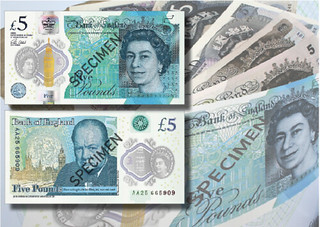 The new £5 polymer note with its long-awaited portrait of Sir Winston Churchill has been one of the most anticipated and talked-about
British banknotes and represents the greatest change since the introduction of color £5 notes in 1957. The May 2016 unveiling of the Bank of
England’s latest superstar was just that—as if a great celebrity had come to town and was looking forward to meeting their excited and awaiting fans.
Blenheim Palace, ancestral home of the Churchills, was the setting—no less for such a superstar—and much of the country’s media had sent
representatives for the occasion to catch a first glimpse of the note in question.
The new £5 polymer note with its long-awaited portrait of Sir Winston Churchill has been one of the most anticipated and talked-about
British banknotes and represents the greatest change since the introduction of color £5 notes in 1957. The May 2016 unveiling of the Bank of
England’s latest superstar was just that—as if a great celebrity had come to town and was looking forward to meeting their excited and awaiting fans.
Blenheim Palace, ancestral home of the Churchills, was the setting—no less for such a superstar—and much of the country’s media had sent
representatives for the occasion to catch a first glimpse of the note in question.
I had an opportunity to speak with Victoria Cleland, chief cashier of the Bank of England (whose signature appears on all Bank of England notes), before the note’s official launch date of September 13. She is directly responsible for insuring the integrity, safety, security, and overall supply of the country’s notes—among other accountabilities. We spoke about the behind-the-scenes of preparing for a new banknote, which posed more challenges than any ordinary change-over from one paper note to another due to the new polymer substrate being introduced. The newly launched “G” series of banknotes will continue to undergo change and addition; the upcoming £10 “Austen” note will also be printed on polymer, and it will be reduced in size to correspond with the new £5 note (which is 15% smaller than the 1990 version) and will change in design.
The £20 denomination will also undergo change by 2020; it will include a portrait of 19th-century painter JMW Turner and will correspond to the new changes in terms of polymer substrate and size. It is clear that the Bank of England are poised to ensure that their notes are well suited to the demands the public expect of their banknotes as well as to guarantee their integrity, and have made great investment in this pursuit. The Bank seems to be looking long-term for continued banknote use, and where the demise of physical notes and coins are predicted to be the “norm” in other countries due to increasing electronic payment methods, don’t count out the pound in your pocket just yet where Bank of England notes are concerned.
Michael Alexander: Hello Victoria, your department unveiled the newly anticipated £5 banknote on June 2, anticipated because of the inclusion of Sir Winston Churchill’s image on the reverse and of course, because it’s the Bank of England’s first note printed on polymer. My first question is when did the Bank of England decide that polymer would be used for this new series—what were the considerations behind the decision?
Victoria Cleland: The Bank of England undertook a research project for about three years, really trying to understand the benefits of polymer compared to other banknote substrates. We looked at polymer, we looked at paper, and we looked at a number of hybrids between paper and polymer. The first one the team was looking at was whether or not polymer would give us increased counterfeit resilience. I think it’s very important to say, it’s not just the substrate, it’s the combination of the substrate and advanced security features that we’re trying to assess. My team spent a lot of time trying to literally counterfeit the notes themselves and they were quite good, quite brilliant. From that, it was essentially showing that polymer notes took longer to counterfeit and it was more difficult to come up with a good-quality polymer note with advanced security features than it was with paper—it’s really raising the bar for counterfeiters.
We also looked at the life of the note and durability, and our tests found out that the polymer notes were cleaner and stronger. So actually, they’re more durable. I keep telling people “they are not indestructible, they’re more difficult to tear than paper ones, but then, it’s not impossible.” But they’ll actually last longer and they tend to stay cleaner. It’s one of the things we’ve had in the post was “we don’t like tatty fivers.” We thought while we have introduced polymer, it should be more difficult to counterfeit and no more tatty notes. We also found out that aside from the longevity, they had environmental impacts that were positive.
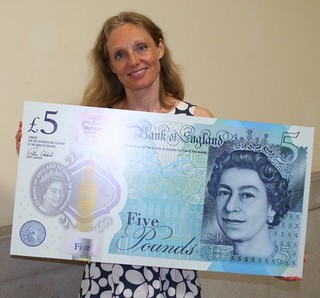
Cleland displays an oversized publicity mockup of the polymer note
To read the complete article, see:
Interview:
Victoria Cleland, Bank of England’s Chief Cashier, Discusses the Country’s New Polymer Banknotes
(http://news.coinupdate.com/interview-virginia-cleland-bank-of-englands-chief-cashier-discusses-the-countrys-new-polymer-banknotes/)
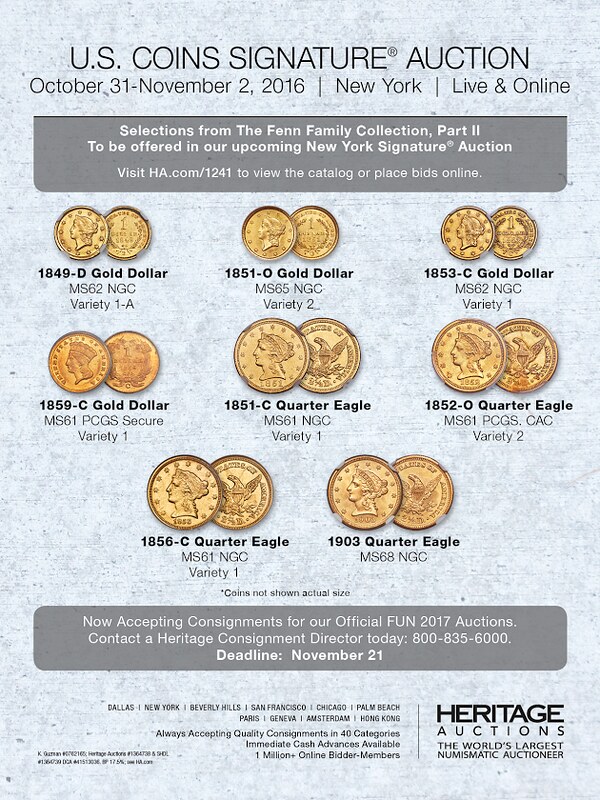
BANK OF CANADA CONSIDERED DROPPING BRITISH MONARCHS
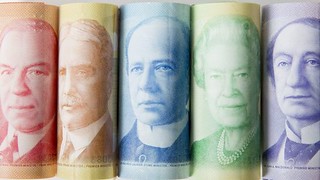 The Bank of Canada considered dispensing with tradition and removing the British monarch from its bank notes in the event of Queen
Elizabeth II dying or abdicating.
The Bank of Canada considered dispensing with tradition and removing the British monarch from its bank notes in the event of Queen
Elizabeth II dying or abdicating.
The issue of Queen Elizabeth's death came up several times at the Bank of Canada between 2007 and 2015, according to documents obtained by Reuters under access-to-information laws.
The longest-reigning British monarch, the Queen appears on all standard Canadian coins, as well as on the C$20 bank note.
The 90-year-old Elizabeth, head of state of 16 Commonwealth countries including Canada and Australia, has reigned since 1952 and remains popular in the Northern American country.
In the documents, central bank staff working on the $20 bank note redesign in 2012 wrote that depicting the reigning British monarch was "a matter of tradition."
"In the event the Queen dies or abdicates before the new notes are issued, a decision will need to be taken as to whether to continue this tradition or to replace the image" with another portrait subject, a 2008 policy advice paper read.
The department did not directly respond to questions on the matter, saying it was focused on previously announced plans to feature a Canadian woman on an upcoming bank note in the 2018 series.
"No other changes are being considered at this time," it said.
Buckingham Palace declined to comment.
To read the complete article, see:
Canada considered ditching Prince Charles from $20 bank note if Queen died
(www.theage.com.au/business/banking-and-finance/canada-considered-ditching-prince-charles-from-20-bank-note-if-queen-died-20161014-gs2yiz.html)

THE OCTOBER 2016 U.S. MINT FORUM
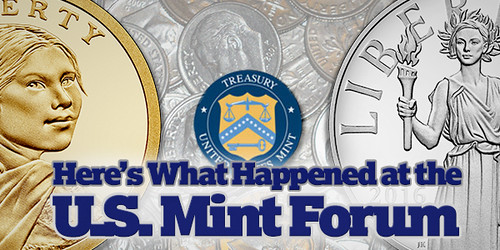
On October 13, 2016, the United States Mint hosted a daylong forum with industry stakeholders at the Federal Reserve Bank of Philadelphia. The purpose of the forum was to open a dialogue between the Mint and the industry in order to find ways to improve the quality of its products and services with the goal of increasing enthusiasm for coin collecting.
About 80 industry leaders and members of the collecting public were in attendance. Participants included representatives from the American Numismatic Association (ANA), the Smithsonian Institution and executives from the two largest coin grading services: Professional Coin Grading Service (PCGS) and Numismatic Guaranty Corporation (NGC).
Representing the hobby’s publishing and media sector were CoinWeek, Coin World, and Whitman Publishing.
The Mint’s own presence at the event was robust. Principal Deputy Director Rhett Jeppson was on hand, as well as Acting Associate Director of the Numismatic and Bullion Division Jon Cameron, Philadelphia Plant Manager Marc Landry, Director of the Office of Corporate Communications Tom Jurkowsky, U.S. Mint Curator Dr. Robert I. Gohler and Sculptor-Engraver Don Everhart.
Curator of the National Numismatic Collection Dr. Ellen Feingold gave an important update on the conservation and cataloging efforts ongoing at the Smithsonian. CoinWeek joined Dr. Feingold and Jeff Garrett in Washington, D.C. last week to film an upcoming segment about the collection.
The morning’s events wrapped up with a panel discussion with industry leaders, led by Garrett. The topic was “Invigorating the Coin Collecting Hobby”.
Those in attendance had many ideas concerning the growth of the hobby and outreach beyond the coin collecting community. Mass market coin collecting starter kits were proposed, as was an idea to seed new circulating coinage using classic designs like the Buffalo nickel and Winged Liberty dime into bags of current mint product for kids (and collectors) to discover. Another idea involved the ANA and Whitman teaming up to donate Red Books to public schools in the communities that host ANA conventions.
After lunch, the Mint split the attendees up into seven working groups. Each group was assigned to deliberate on a particular issue. The topics were: Packaging; Mintage/Household Order Limits; Medals; Who is our Customer of the Future/Customer Engagement; Working with Youth; Historic Design Reproduction; and America the Beautiful (AtB) Follow-on.
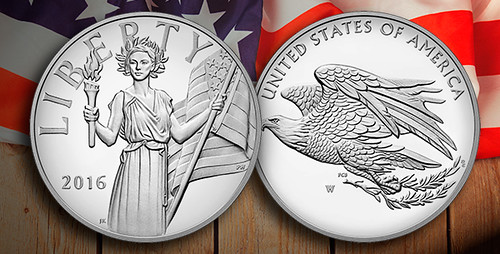
To read the complete article, see:
U.S. Mint Seeks Industry, Collector
Insights at Numismatic Forum (www.coinweek.com/us-mint-news/u-s-mint-seeks-industry-collector-insights-numismatic-forum/)
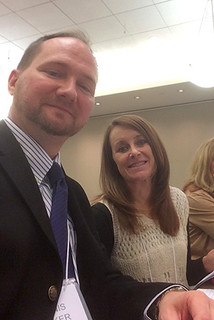 As the Mint approaches its 225th anniversary of coinage (which will be celebrated in 2017), it faces a recent trend of declining collector
sales and a diminishing mailing list. The Mint sees this Numismatic Forum as the beginning of a strengthening relationship with the entire community,
to reverse those trends and reinvigorate the hobby.
As the Mint approaches its 225th anniversary of coinage (which will be celebrated in 2017), it faces a recent trend of declining collector
sales and a diminishing mailing list. The Mint sees this Numismatic Forum as the beginning of a strengthening relationship with the entire community,
to reverse those trends and reinvigorate the hobby.
Mary Burleson and I went to the forum as, respectively, the president and publisher for Whitman Publishing—maker of the annual “Red Book” and a company that obviously has a very keen interest in the hobby, with experience going back to the collecting boom of the early 1930s. I also represented the Citizens Coinage Advisory Committee, along with three other members in attendance: Donald Scarinci, Thomas Uram, and CCAC chair Mary Lannin.
The Numismatic Forum was an enlightening, productive event, and one that should produce valuable results (with ongoing work and dedication). It brought together diverse voices and viewpoints, from big-time coin dealers to museum curators to active collectors, and everyone in-between.
In a series of articles beginning this weekend, I’ll introduce you to some of the Mint officials and others who participated in the Forum, and I’ll share some of the ideas and discussions that came out of it. Coin packaging; mintage and household order limits; medals; customer engagement; youth involvement; historic design reproduction; and the future of the golden dollar and quarter dollar programs were some of the themes explored. Stay tuned—and I welcome your comments and ideas.
To read the complete articles, see:
Invigorating
the Coin-Collecting Hobby: United States Mint Holds a Numismatic Forum in Philadelphia
(http://mintnewsblog.com/2016/10/invigorating-the-coin-collecting-hobby-united-states-mint-holds-a-numismatic-forum-in-philadelphia/)
“Invigorating the Coin Collecting Hobby,” Part 2: Get to Know the People at the United States Mint, the Smithsonian, and the American Numismatic
Association
(http://mintnewsblog.com/2016/10/invigorating-the-coin-collecting-hobby-part-2-get-to-know-the-people-at-the-united-states-mint-the-smithsonian-and-the-american-numismatic-association/)
THE BOOK BAZARRE
PROPOSALS ADVOCATE ELIMINATING CENT AND NICKEL
IT’S TIME FOR A DECISION!
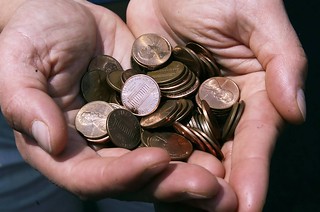 Hooray! Two authors this week agree with what I have been advocating for a decade. One author in the New York Times and one in
Big Think.
Hooray! Two authors this week agree with what I have been advocating for a decade. One author in the New York Times and one in
Big Think.
The proposal is to eliminate both the cent and the nickel from circulation. Stop minting these and save $39 million a year it’s costing taxpayers for the cent alone. Match that for nickels and we’re talking real money.
Round off all transactions to the nearest ten cents. Make the dime the lowest denomination for all prices, thus all the amounts at the bottom line of every invoice, every bill, the amount on every check. The dime becomes the 21st century penny coin –the lowest value for circulation and accounting.
The cent is irrelevant these days. You can’t buy anything with a single cent. The public is dismissing them in every way. Yet the Mints churn out four and a half billion a year. For what purpose? To end up in a dresser drawer, or cast in a fountain, to remain unspent. They are not fulfilling their intended purpose of a circulating medium of exchange.
Canada eliminated their cent in 2005, Australia, however, was the first to ax their cent and two-cent coins in 1990, followed by their 5-cent coin in 2009. Hasn’t damaged their economy. Canadians and Australians are happy not to have to carry around such minute value coins. Savings abound and no problems resulting in rounding off the the nearest 10-cents, no gouging buyers as the critics in America have stated would happen.
Fourteen countries have eliminated their lowest value coin. America, financial capital of the world, is procrastinating. We should have been out front in this movement long ago.
For years I have proposed dropping the cent, nickel and quarter, retaining the dime, half dollar and dollar, then adding three new coins, the $5, $10 and $20 denominations. If this is not done soon our coins – the use of all our coins -- will become obsolete as every transaction will become digital.
I have a plan how this can be done without cost to the taxpayers, with an actual profit from seignorage of the new denominations. However the problem is what to do with all those coins in circulation. That’s a lot of metal, tons and tons of it.
I have a solution. It won’t cost the Treasury a six-figure consulting fee, as they have spent trying to find a substitute composition costing less than face value of the coins.
There are three readers of The E-Sylum at the U.S. Treasury. Call me. I’ll disclose my plan in full. My number is 860-482-1103.
Meanwhile read the two articles which appeared this week: http://bigthink.com/arpan-bhattacharyya/pennies-arent-not-worth-it by Arpan Bhattacharyya. You’ll laugh at the line under the illustration.
http://www.nytimes.com/2016/10/11/insider/why-doesnt-the-united-states-finally-get-rid-of-the-penny.html?_r=1 by Binyamin Appelbaum.
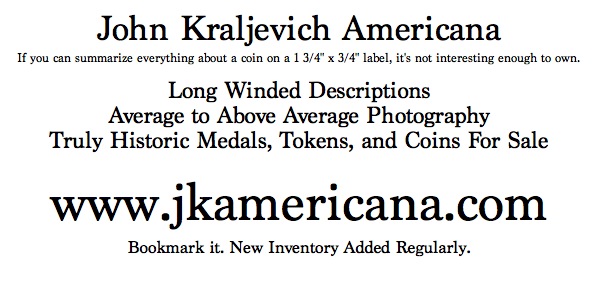
WHERE CASH IS NO GOOD
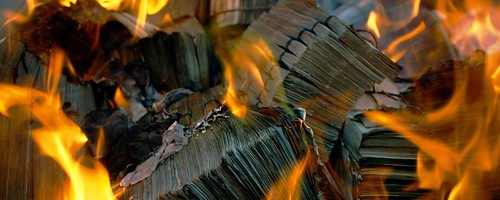
My dad, a former Wall Street trader always advised me “cash is king” and to “hold on to it” when the economy gets tough.
But in the Netherlands, cash is definitely not getting the royal treatment. In so many places, it has simply ceased to be recognised as legal tender. More and more Dutch stores, from upscale health-food store Marqt to my local baker and bagel shop, take pin — or debit — cards exclusively. Some retailers even describe going cash-free as “cleaner” or “safer”. Tucking my debit card firmly away, I decide to see how far a bundle of cash will get me. Not far. The big-ticket items are strictly cashless affairs: my rent and my telephone bill among them.
I meet with baffled expressions and some resistance. “I can’t remember the last time we received a cash payment,” says Marielle Groentjes, an administrator with the company that manages my apartment, Hoen Property Management BV, and has worked there for a decade. “We don’t like cash in the office, we don’t have a safe, and banks charge you for depositing it.”
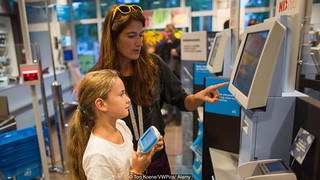 But it’s the smaller items that are giving me the biggest headaches. Not only can I not buy my organic produce at Marqt, but I am forced to
wait in long cash-only lines at the supermarket while I watch those with debit cards quickly pay up and make it home for dinner. When I try to buy a
tuna sandwich at Dutch bakery chain Vlaams Broodhuys, my cash is rejected. I can’t even use my euros to pay for parking in much of the city.
But it’s the smaller items that are giving me the biggest headaches. Not only can I not buy my organic produce at Marqt, but I am forced to
wait in long cash-only lines at the supermarket while I watch those with debit cards quickly pay up and make it home for dinner. When I try to buy a
tuna sandwich at Dutch bakery chain Vlaams Broodhuys, my cash is rejected. I can’t even use my euros to pay for parking in much of the city.
“Cash is a dinosaur, but it will stay,” says Michiel van Doeveren, a senior policy advisor at the Dutch central bank, DNB (De Nederlandsche Bank). But he points out it's the logistics that make handling cash expensive (it must be transported, guarded, tallied and registered) versus the ease of electronic payments. “It’s important that the electronic economy increases. We want to foster more efficient payments.”
Electronic payments in the Netherlands’ shops and supermarkets overtook cash payments for the first time in 2015 by a narrow margin: 50% debit cards while 49.5% were paid for in cash the remaining 0.5% were credit card-payments.
To read the complete article, see:
The Countries Where Cash Is On The Verge
of Extinction (www.bbc.com/capital/story/20160922-the-countries-where-cash-is-on-the-verge-of-extinction)

COMPANY RECOVERS COINS FROM TRASH
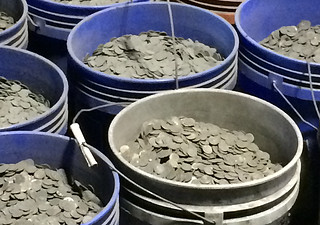 There’s a Covanta Holding Corp. incinerator outside Philadelphia that produces electricity from burning garbage. It also produces something
else: stacks and stacks of blackened, sooty coins.
There’s a Covanta Holding Corp. incinerator outside Philadelphia that produces electricity from burning garbage. It also produces something
else: stacks and stacks of blackened, sooty coins.
Over the course of a year, those nickels, dimes and quarters add up to about $360,000. That’s seven times the average income in the Philadelphia metropolitan region, and the money is piling up as Covanta waits for the U.S. Mint to resume coin purchases under an exchange program it suspended in November.
About $61.8 million of loose change is accidentally thrown away every year in the U.S., Covanta estimates. The coins get swept off restaurant tables, mixed in with scraps when people empty their pockets, and vacuumed up from carpets or sofa cushions. The money used to end up in the dump, but as trash volume increases and open space dwindles, landfill-disposal costs are up 25 percent in the past decade. That’s created an incentive for Covanta and other companies to develop ways to sift through mountains of garbage and extract steel, iron, aluminum and copper for sale to recyclers.
“It’s amazing what people throw away,” said Alex Piscitelli, who manages the plant in Chester, Pennsylvania, where Covanta developed its technique to separate change from other burnt metal.
Covanta stepped up its efforts in 2011 to recover metals from the ashes at its power plants, spending about $70 million on powerful magnets and other equipment. Over five years, it has recovered more than 2 million tons of metal that was sold to recycling companies. That generated $61 million last year, or 3.7 percent of Covanta’s revenue. In 2017, the company plans to open a central facility to sort aluminum, copper and coins captured at plants in the Northeast and Mid-Atlantic.
However, Covanta’s coin recovery effort has been on hold for almost a year. The U.S. Mint used to buy salvaged change from almost anyone, usually melting it down to make new coins. But the government suspended all purchases in November amid suspicions of counterfeiting by some sellers. Prosecutors filed a civil forfeiture suit accusing three companies of cashing in $5.5 million in fake coins imported from China.
A federal judge in Philadelphia dismissed the case in July after the companies reached a settlement with prosecutors. The Mint, meanwhile, has declined to say whether it will resume accepting damaged coins after the order suspending the program expires Nov. 2. That’s left Covanta, which wasn’t involved in the case, stockpiling buckets of sooty nickels, dimes and quarters.
“You can’t return them to the bank,” said Steve Bossotti, Covanta’s senior vice president of metals management. “You can’t melt them down. You basically have to wait to see what the Mint does.”
To read the complete article, see:
We Toss $62 Million of
Loose Change Every Year. This Company Wants Some of It
(www.bloomberg.com/news/articles/2016-10-12/trash-piles-yield-treasure-as-sifters-seek-sooty-coins-in-ashes)

MAN BUYS UNDERWEAR WITH COUNTERFEIT MONEY
A Canton man was arrested shortly after he used a counterfeit $50 bill to buy underwear at a local Kmart, Stark County jail and court records show.
Kyle T. Pinkney, 32, of 2323 Spring Ave. NE, was arrested at 1:30 p.m. Thursday at 17th Street and Lincoln Way E in Massillon on a forgery charge and an unrelated warrant charging him with failure to have a motorcycle endorsement, the jail records said.
Police say that a half hour earlier, he had gone into a local Kmart, where he tried to pay for a $10.99 pack of underwear with a counterfeit $50 bill.
To read the complete article, see:
Man buys underwear with counterfeit money
(www.cantonrep.com/news/20161014/man-buys-underwear-with-counterfeit-money)
IMAGES OF ALIENS ON WEIRD COINS
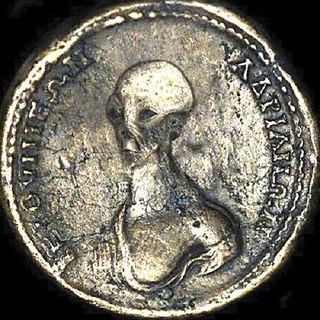 New coins discovered in Egyptian houses seem to point to the co-existence of Aliens with humans centuries ago, say ufologists.
New coins discovered in Egyptian houses seem to point to the co-existence of Aliens with humans centuries ago, say ufologists.
If you see freaky coins with figures of huge, bald heads and bulbous eyes, you will begin to wonder if humans were ever ruled by extra-terrestrials. Another coin depicts a spaceship coming down on dry land.
Did the aliens once share the Earth with us? That is what Conspiracy website mysteriousearth.net reveals. One coin has a Latin engraving, "OPPORTUNUS Adest" on one of its faces. It means: "It's here in due time".
To read the complete article, see:
UFO sighting: Do images of
Aliens on weird coins prove that they visited Earth?
(www.hngn.com/articles/211845/20161015/ufo-sighting-images-aliens-weird-coins-prove-visited-earth.htm)
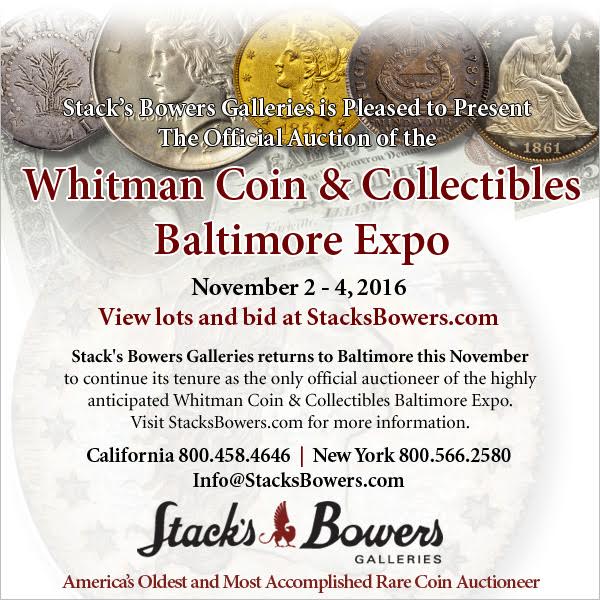
FEATURED WEB PAGE: HOBBY PROTECTION ACT
This week's Featured Web Page is the U.S. Federal Trade Commission's Hobby Protection Act.The Hobby Protection Act, passed by Congress in 1973, covers imitation political items (e.g., buttons, posters, stickers, etc.), as well as imitation numismatic items (e.g., various coins, tokens, paper money, commemorative medals) that are required to be marked with certain identifying information in an effort to flag them as imitations. The FTC’s Rule establishes the size of the required disclosures, their location, and the manner in which items may be marked.
www.ftc.gov/enforcement/rules/rulemaking-
regulatory-reform-proceedings/hobby-protection-act

